Network Operating System: Types, Implementation, and Disaster Recovery
VerifiedAdded on 2023/06/10
|32
|6410
|441
AI Summary
This guide covers the different types of network operating systems, including batch, time-sharing, distributed, network, and real-time operating systems. It also includes an implementation plan for NOS, disaster recovery, and network management. The recommended NOS is Windows Server 2016. The guide also discusses backup options and devices, including full, incremental, and differential backups.
Contribute Materials
Your contribution can guide someone’s learning journey. Share your
documents today.

Network Operating System 1
Network Operating System
Student Name
Affiliate Institution
Network Operating System
Student Name
Affiliate Institution
Secure Best Marks with AI Grader
Need help grading? Try our AI Grader for instant feedback on your assignments.

Network Operating System 2
Table of Contents
1 LO1 Understand network operating systems principles.......................................................................3
1.1 Types of operating systems..........................................................................................................3
1.1.1 Batch Operating System.......................................................................................................3
1.1.2 Time-Sharing Operating Systems........................................................................................3
1.1.3 Distributed Operating Systems............................................................................................4
1.1.4 Network Operating System..................................................................................................4
1.1.5 Real-Time Operating Systems.............................................................................................5
1.1.6 Summary of Types of Network Operating Systems.............................................................5
1.1.7 My Recommended Network Operating System...................................................................8
1.2 Business Continuity and Disaster Recovery................................................................................9
1.2.1 Advantages of the Disaster Recovery Plan..........................................................................9
1.2.2 Types of backup options and devices...................................................................................9
1.2.3 Backup options....................................................................................................................9
1.2.4 Different RAID options in relation to availability..............................................................11
2 LO2: Network operating systems implementations plan...................................................................12
2.1 Plan for the Implementation of NOS..........................................................................................12
2.1.1 Installation.........................................................................................................................12
2.1.2 IP addressing......................................................................................................................13
2.1.3 Network Security Policies..................................................................................................14
2.2 Justification of Evaluation Plan and User Feedback..................................................................15
3 LO3: Network Operating system Implementation.............................................................................15
3.1 Step by step installation and configuration of windows server 2016..........................................15
3.1.1 Configuring Network Services...........................................................................................22
3.2 Configuration and Testing of Password Security Policy............................................................24
3.2.1 Threat and Password Permission Policy.............................................................................24
3.2.2 Network Performance and Availability..............................................................................25
4 LO4: Network Management..............................................................................................................26
4.1 Network Monitoring Tool..........................................................................................................26
4.1.1 Justification........................................................................................................................26
4.2 Network Monitoring against Threats.........................................................................................27
Reference List............................................................................................................................................28
Table of Contents
1 LO1 Understand network operating systems principles.......................................................................3
1.1 Types of operating systems..........................................................................................................3
1.1.1 Batch Operating System.......................................................................................................3
1.1.2 Time-Sharing Operating Systems........................................................................................3
1.1.3 Distributed Operating Systems............................................................................................4
1.1.4 Network Operating System..................................................................................................4
1.1.5 Real-Time Operating Systems.............................................................................................5
1.1.6 Summary of Types of Network Operating Systems.............................................................5
1.1.7 My Recommended Network Operating System...................................................................8
1.2 Business Continuity and Disaster Recovery................................................................................9
1.2.1 Advantages of the Disaster Recovery Plan..........................................................................9
1.2.2 Types of backup options and devices...................................................................................9
1.2.3 Backup options....................................................................................................................9
1.2.4 Different RAID options in relation to availability..............................................................11
2 LO2: Network operating systems implementations plan...................................................................12
2.1 Plan for the Implementation of NOS..........................................................................................12
2.1.1 Installation.........................................................................................................................12
2.1.2 IP addressing......................................................................................................................13
2.1.3 Network Security Policies..................................................................................................14
2.2 Justification of Evaluation Plan and User Feedback..................................................................15
3 LO3: Network Operating system Implementation.............................................................................15
3.1 Step by step installation and configuration of windows server 2016..........................................15
3.1.1 Configuring Network Services...........................................................................................22
3.2 Configuration and Testing of Password Security Policy............................................................24
3.2.1 Threat and Password Permission Policy.............................................................................24
3.2.2 Network Performance and Availability..............................................................................25
4 LO4: Network Management..............................................................................................................26
4.1 Network Monitoring Tool..........................................................................................................26
4.1.1 Justification........................................................................................................................26
4.2 Network Monitoring against Threats.........................................................................................27
Reference List............................................................................................................................................28

Network Operating System 3
1 LO1 Understand network operating systems principles
1.1 Types of operating systems
Being known to be one of the important software in a computer, an operating system is
set to the tasks of managing the memory and processes of a computer including both the
hardware and software part of a computer. You can with the help of an operating system
communicate with a computer without talking to it. A computer, therefore, can be declared to be
useless without an operating system (Technopedia, 2018). Since the error of first computer
generation, an operating system has been there despite all the evolving processes that are known.
There are a number of types of operating systems which I am going to share in this chapter.
1.1.1 Batch Operating System
In this type, there is no direct interaction between the users of the operating system with
the computer (Pillai, 2017). Users have to involve the services of off-line devices a good
example being punch cards to be able to prepare their jobs and there after they submit them to
the computer operator. There is a need for batching jobs with similar characters together and
running them as a group so as to speed up the processing rates (Anderson, 2018). It is usually
the work of the operator to make sure that the jobs that are left with him by the programmers are
sort into batches with respect to similar requirements. There are some disadvantages that came
with Batch Systems like the absence of user job interaction, slower speed due to delayed
mechanical input-output processes, and poor prioritization.
1.1.2 Time-Sharing Operating Systems
Here, users located at different locations are able to use a particular computer just at the
same time. This is also referred to by many as multitasking or a logical continuation of
multiprogramming. The time of the processor that is shared by many users at the same time is
1 LO1 Understand network operating systems principles
1.1 Types of operating systems
Being known to be one of the important software in a computer, an operating system is
set to the tasks of managing the memory and processes of a computer including both the
hardware and software part of a computer. You can with the help of an operating system
communicate with a computer without talking to it. A computer, therefore, can be declared to be
useless without an operating system (Technopedia, 2018). Since the error of first computer
generation, an operating system has been there despite all the evolving processes that are known.
There are a number of types of operating systems which I am going to share in this chapter.
1.1.1 Batch Operating System
In this type, there is no direct interaction between the users of the operating system with
the computer (Pillai, 2017). Users have to involve the services of off-line devices a good
example being punch cards to be able to prepare their jobs and there after they submit them to
the computer operator. There is a need for batching jobs with similar characters together and
running them as a group so as to speed up the processing rates (Anderson, 2018). It is usually
the work of the operator to make sure that the jobs that are left with him by the programmers are
sort into batches with respect to similar requirements. There are some disadvantages that came
with Batch Systems like the absence of user job interaction, slower speed due to delayed
mechanical input-output processes, and poor prioritization.
1.1.2 Time-Sharing Operating Systems
Here, users located at different locations are able to use a particular computer just at the
same time. This is also referred to by many as multitasking or a logical continuation of
multiprogramming. The time of the processor that is shared by many users at the same time is

Network Operating System 4
what is simply termed as time-sharing (Chasing, 2018). When differentiating between Time-
Sharing and Batch Systems, in Time-Sharing, the main objective here is to reduce response time
whereas, in Batch Systems, the main objective is to reduce processor time. Time-Sharing
Operating Systems have the advantages like Quick response time, reduced CPU idle time, and
there is no duplication of software. However, it is disadvantaged in terms of reliability, poor data
communication, and the user’s data is not very secure in this type of Operating System
(Networks, 2015).
1.1.3 Distributed Operating Systems
Multiple users and multiple real-time applications are served by multiple central
processors in these types of operating systems. There is the distribution of jobs among the
processors accordingly (chennaicisco. 2013). Various communication lines are used by the
processors like the likes of high-speed buses to communicate to each other. Distributed systems
are also referred to by many people as loosely coupled systems. This types of Operating
Systems have the advantages like a high rate of data exchange through electronic mail, sharing of
resources among users, the robustness of the system since the failure of one site does not affect
the other, minimal delay in processing data, and the host computer is relieved a lot of burdens
(Mullins, 2018).
1.1.4 Network Operating System
This type is set to run on the server allowing the serve r to manage users, data, security,
applications and many more tasks (Cisco, 2013). This type mainly came to enable sharing of
resources among users over the network. There are examples of network operating systems like
Linux, Unix, Mac OS, Microsoft Windows Server 2003 among others. This type has the
advantages of good server managed security protocol, the stability of centralized servers, easy
upgrade process, and the advantage of remote access (ComputerNetworkingNotes. 2018).
what is simply termed as time-sharing (Chasing, 2018). When differentiating between Time-
Sharing and Batch Systems, in Time-Sharing, the main objective here is to reduce response time
whereas, in Batch Systems, the main objective is to reduce processor time. Time-Sharing
Operating Systems have the advantages like Quick response time, reduced CPU idle time, and
there is no duplication of software. However, it is disadvantaged in terms of reliability, poor data
communication, and the user’s data is not very secure in this type of Operating System
(Networks, 2015).
1.1.3 Distributed Operating Systems
Multiple users and multiple real-time applications are served by multiple central
processors in these types of operating systems. There is the distribution of jobs among the
processors accordingly (chennaicisco. 2013). Various communication lines are used by the
processors like the likes of high-speed buses to communicate to each other. Distributed systems
are also referred to by many people as loosely coupled systems. This types of Operating
Systems have the advantages like a high rate of data exchange through electronic mail, sharing of
resources among users, the robustness of the system since the failure of one site does not affect
the other, minimal delay in processing data, and the host computer is relieved a lot of burdens
(Mullins, 2018).
1.1.4 Network Operating System
This type is set to run on the server allowing the serve r to manage users, data, security,
applications and many more tasks (Cisco, 2013). This type mainly came to enable sharing of
resources among users over the network. There are examples of network operating systems like
Linux, Unix, Mac OS, Microsoft Windows Server 2003 among others. This type has the
advantages of good server managed security protocol, the stability of centralized servers, easy
upgrade process, and the advantage of remote access (ComputerNetworkingNotes. 2018).
Secure Best Marks with AI Grader
Need help grading? Try our AI Grader for instant feedback on your assignments.
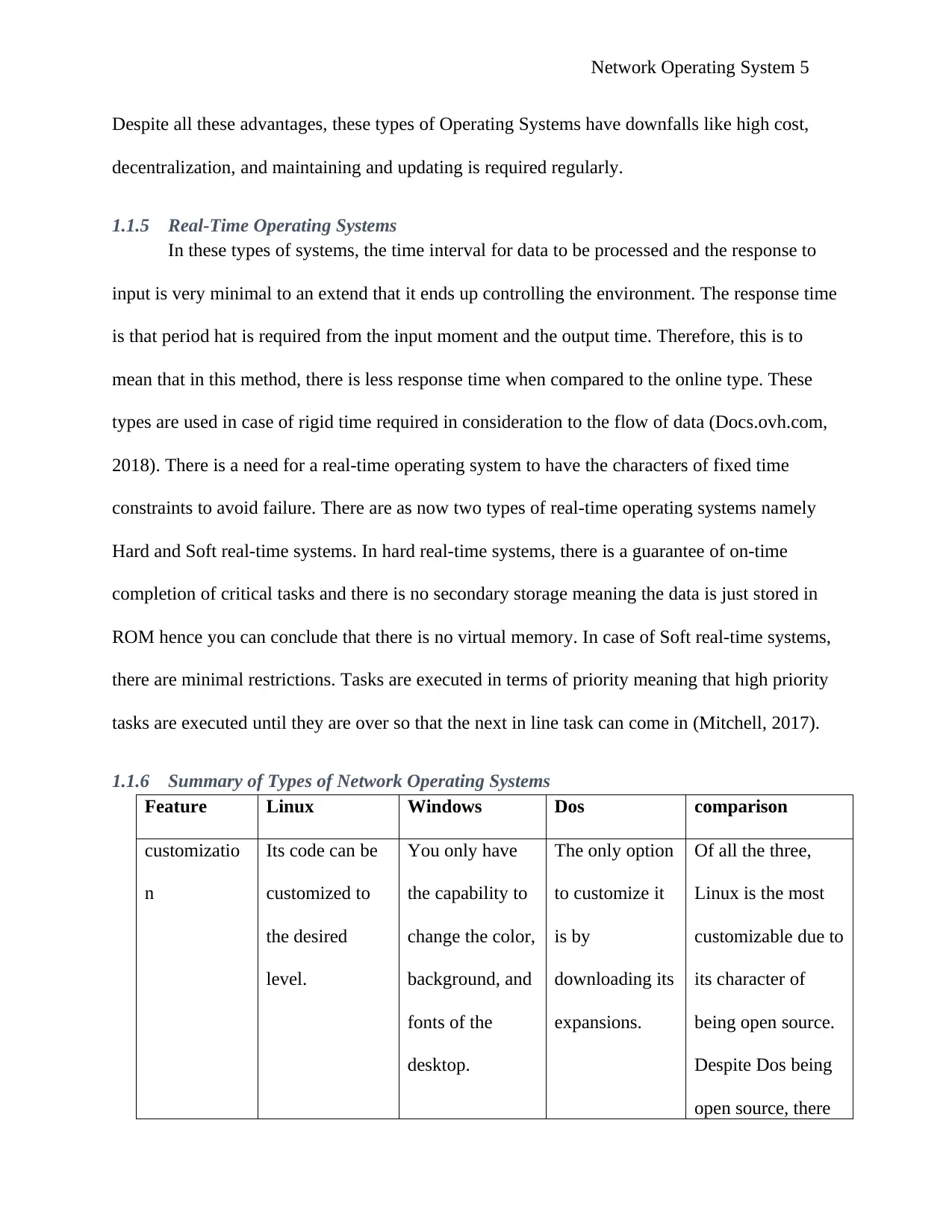
Network Operating System 5
Despite all these advantages, these types of Operating Systems have downfalls like high cost,
decentralization, and maintaining and updating is required regularly.
1.1.5 Real-Time Operating Systems
In these types of systems, the time interval for data to be processed and the response to
input is very minimal to an extend that it ends up controlling the environment. The response time
is that period hat is required from the input moment and the output time. Therefore, this is to
mean that in this method, there is less response time when compared to the online type. These
types are used in case of rigid time required in consideration to the flow of data (Docs.ovh.com,
2018). There is a need for a real-time operating system to have the characters of fixed time
constraints to avoid failure. There are as now two types of real-time operating systems namely
Hard and Soft real-time systems. In hard real-time systems, there is a guarantee of on-time
completion of critical tasks and there is no secondary storage meaning the data is just stored in
ROM hence you can conclude that there is no virtual memory. In case of Soft real-time systems,
there are minimal restrictions. Tasks are executed in terms of priority meaning that high priority
tasks are executed until they are over so that the next in line task can come in (Mitchell, 2017).
1.1.6 Summary of Types of Network Operating Systems
Feature Linux Windows Dos comparison
customizatio
n
Its code can be
customized to
the desired
level.
You only have
the capability to
change the color,
background, and
fonts of the
desktop.
The only option
to customize it
is by
downloading its
expansions.
Of all the three,
Linux is the most
customizable due to
its character of
being open source.
Despite Dos being
open source, there
Despite all these advantages, these types of Operating Systems have downfalls like high cost,
decentralization, and maintaining and updating is required regularly.
1.1.5 Real-Time Operating Systems
In these types of systems, the time interval for data to be processed and the response to
input is very minimal to an extend that it ends up controlling the environment. The response time
is that period hat is required from the input moment and the output time. Therefore, this is to
mean that in this method, there is less response time when compared to the online type. These
types are used in case of rigid time required in consideration to the flow of data (Docs.ovh.com,
2018). There is a need for a real-time operating system to have the characters of fixed time
constraints to avoid failure. There are as now two types of real-time operating systems namely
Hard and Soft real-time systems. In hard real-time systems, there is a guarantee of on-time
completion of critical tasks and there is no secondary storage meaning the data is just stored in
ROM hence you can conclude that there is no virtual memory. In case of Soft real-time systems,
there are minimal restrictions. Tasks are executed in terms of priority meaning that high priority
tasks are executed until they are over so that the next in line task can come in (Mitchell, 2017).
1.1.6 Summary of Types of Network Operating Systems
Feature Linux Windows Dos comparison
customizatio
n
Its code can be
customized to
the desired
level.
You only have
the capability to
change the color,
background, and
fonts of the
desktop.
The only option
to customize it
is by
downloading its
expansions.
Of all the three,
Linux is the most
customizable due to
its character of
being open source.
Despite Dos being
open source, there
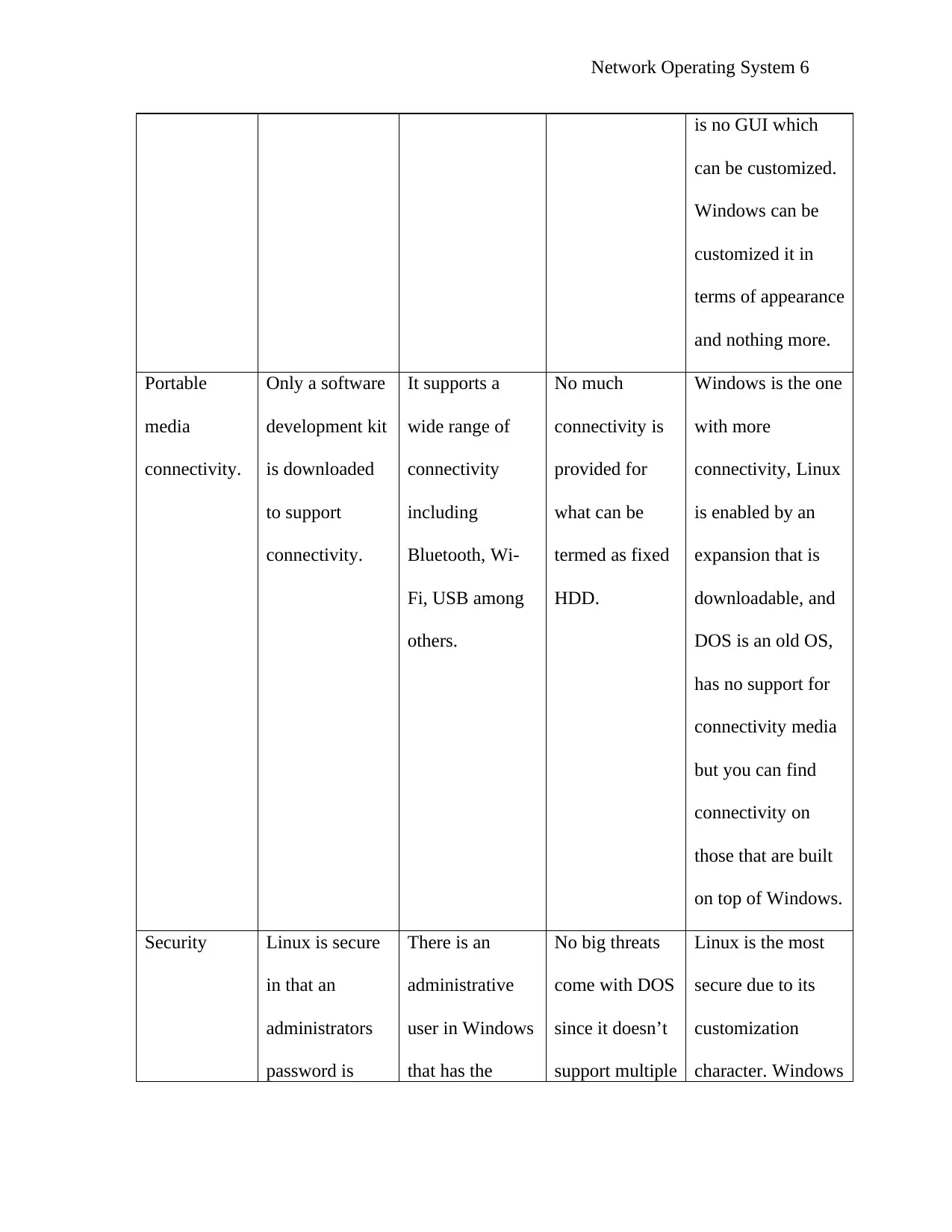
Network Operating System 6
is no GUI which
can be customized.
Windows can be
customized it in
terms of appearance
and nothing more.
Portable
media
connectivity.
Only a software
development kit
is downloaded
to support
connectivity.
It supports a
wide range of
connectivity
including
Bluetooth, Wi-
Fi, USB among
others.
No much
connectivity is
provided for
what can be
termed as fixed
HDD.
Windows is the one
with more
connectivity, Linux
is enabled by an
expansion that is
downloadable, and
DOS is an old OS,
has no support for
connectivity media
but you can find
connectivity on
those that are built
on top of Windows.
Security Linux is secure
in that an
administrators
password is
There is an
administrative
user in Windows
that has the
No big threats
come with DOS
since it doesn’t
support multiple
Linux is the most
secure due to its
customization
character. Windows
is no GUI which
can be customized.
Windows can be
customized it in
terms of appearance
and nothing more.
Portable
media
connectivity.
Only a software
development kit
is downloaded
to support
connectivity.
It supports a
wide range of
connectivity
including
Bluetooth, Wi-
Fi, USB among
others.
No much
connectivity is
provided for
what can be
termed as fixed
HDD.
Windows is the one
with more
connectivity, Linux
is enabled by an
expansion that is
downloadable, and
DOS is an old OS,
has no support for
connectivity media
but you can find
connectivity on
those that are built
on top of Windows.
Security Linux is secure
in that an
administrators
password is
There is an
administrative
user in Windows
that has the
No big threats
come with DOS
since it doesn’t
support multiple
Linux is the most
secure due to its
customization
character. Windows
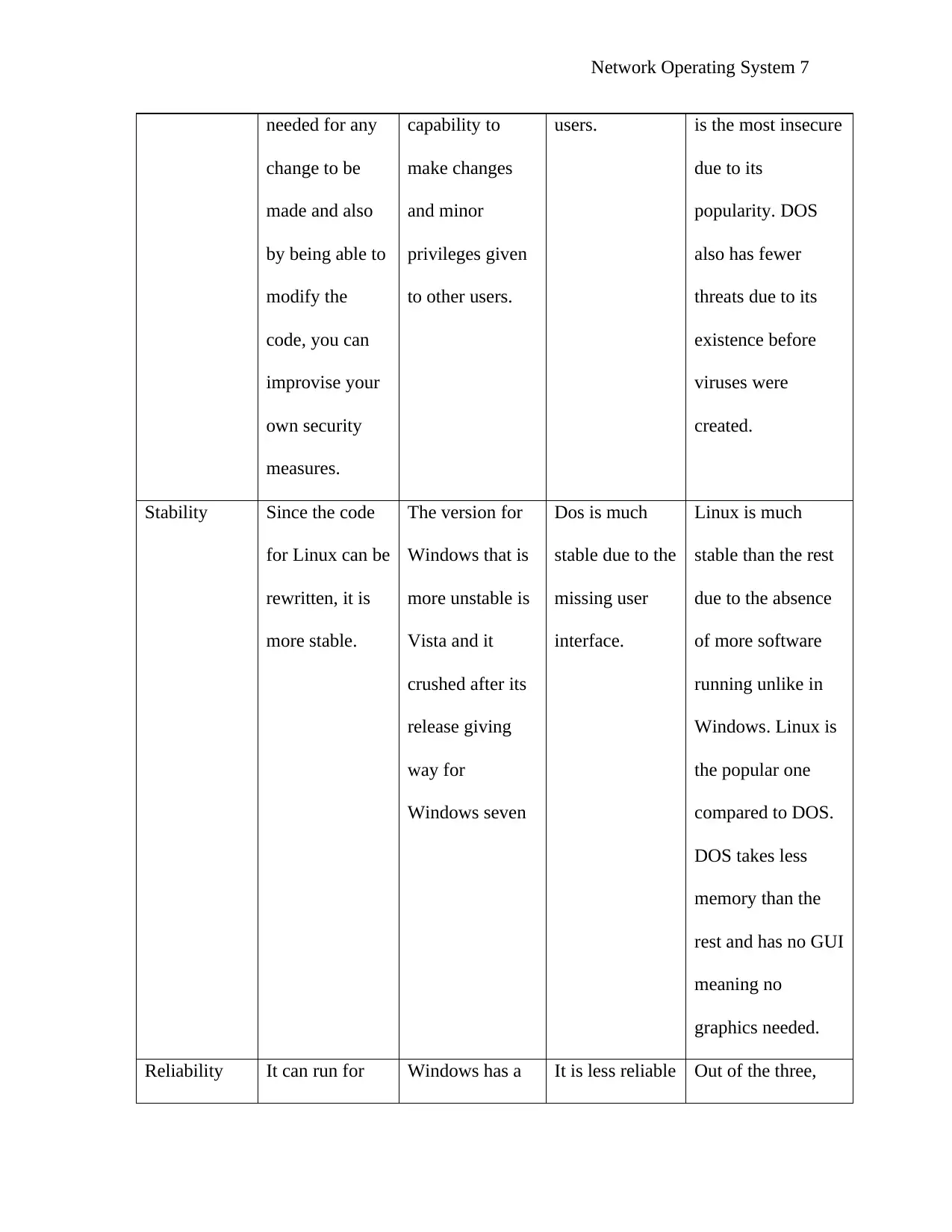
Network Operating System 7
needed for any
change to be
made and also
by being able to
modify the
code, you can
improvise your
own security
measures.
capability to
make changes
and minor
privileges given
to other users.
users. is the most insecure
due to its
popularity. DOS
also has fewer
threats due to its
existence before
viruses were
created.
Stability Since the code
for Linux can be
rewritten, it is
more stable.
The version for
Windows that is
more unstable is
Vista and it
crushed after its
release giving
way for
Windows seven
Dos is much
stable due to the
missing user
interface.
Linux is much
stable than the rest
due to the absence
of more software
running unlike in
Windows. Linux is
the popular one
compared to DOS.
DOS takes less
memory than the
rest and has no GUI
meaning no
graphics needed.
Reliability It can run for Windows has a It is less reliable Out of the three,
needed for any
change to be
made and also
by being able to
modify the
code, you can
improvise your
own security
measures.
capability to
make changes
and minor
privileges given
to other users.
users. is the most insecure
due to its
popularity. DOS
also has fewer
threats due to its
existence before
viruses were
created.
Stability Since the code
for Linux can be
rewritten, it is
more stable.
The version for
Windows that is
more unstable is
Vista and it
crushed after its
release giving
way for
Windows seven
Dos is much
stable due to the
missing user
interface.
Linux is much
stable than the rest
due to the absence
of more software
running unlike in
Windows. Linux is
the popular one
compared to DOS.
DOS takes less
memory than the
rest and has no GUI
meaning no
graphics needed.
Reliability It can run for Windows has a It is less reliable Out of the three,
Paraphrase This Document
Need a fresh take? Get an instant paraphrase of this document with our AI Paraphraser
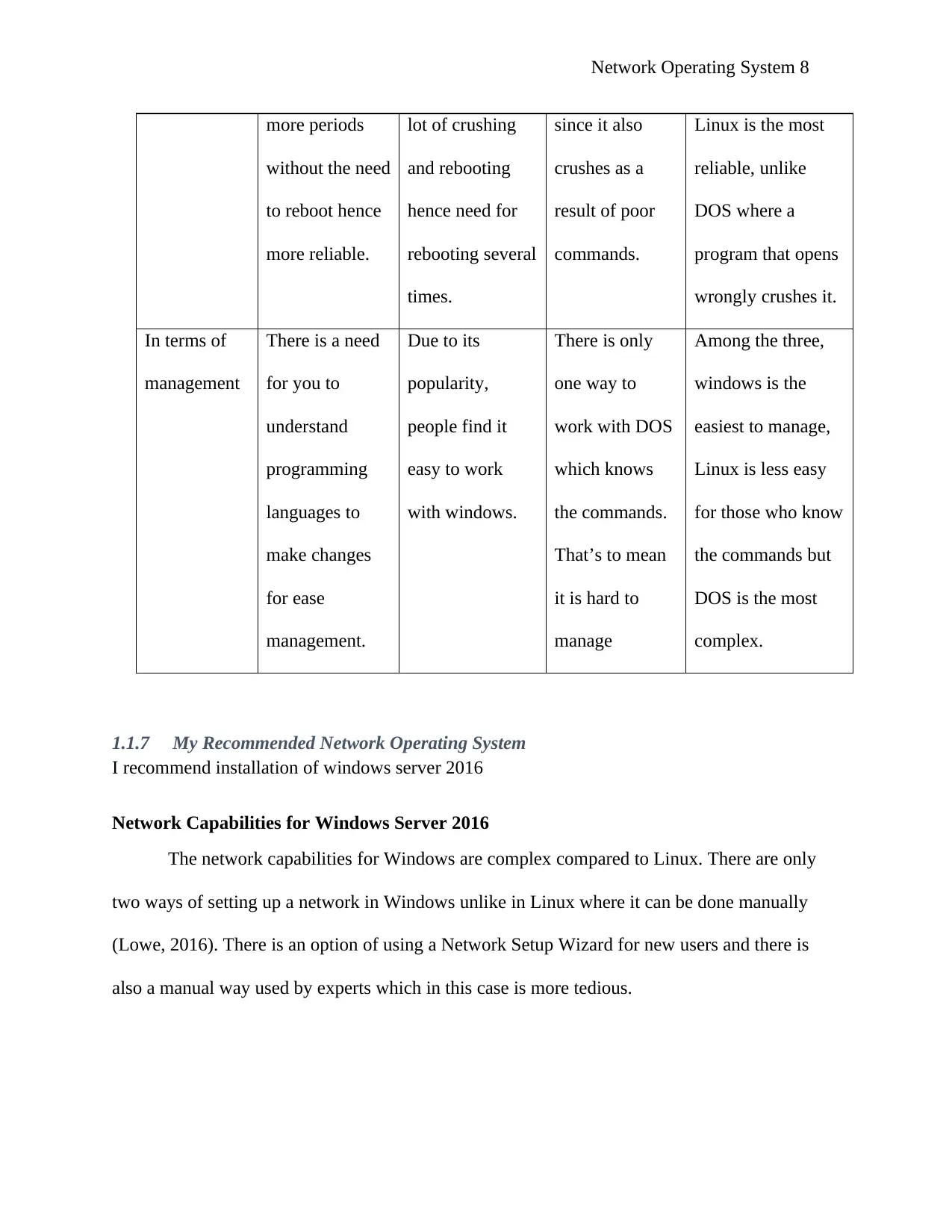
Network Operating System 8
more periods
without the need
to reboot hence
more reliable.
lot of crushing
and rebooting
hence need for
rebooting several
times.
since it also
crushes as a
result of poor
commands.
Linux is the most
reliable, unlike
DOS where a
program that opens
wrongly crushes it.
In terms of
management
There is a need
for you to
understand
programming
languages to
make changes
for ease
management.
Due to its
popularity,
people find it
easy to work
with windows.
There is only
one way to
work with DOS
which knows
the commands.
That’s to mean
it is hard to
manage
Among the three,
windows is the
easiest to manage,
Linux is less easy
for those who know
the commands but
DOS is the most
complex.
1.1.7 My Recommended Network Operating System
I recommend installation of windows server 2016
Network Capabilities for Windows Server 2016
The network capabilities for Windows are complex compared to Linux. There are only
two ways of setting up a network in Windows unlike in Linux where it can be done manually
(Lowe, 2016). There is an option of using a Network Setup Wizard for new users and there is
also a manual way used by experts which in this case is more tedious.
more periods
without the need
to reboot hence
more reliable.
lot of crushing
and rebooting
hence need for
rebooting several
times.
since it also
crushes as a
result of poor
commands.
Linux is the most
reliable, unlike
DOS where a
program that opens
wrongly crushes it.
In terms of
management
There is a need
for you to
understand
programming
languages to
make changes
for ease
management.
Due to its
popularity,
people find it
easy to work
with windows.
There is only
one way to
work with DOS
which knows
the commands.
That’s to mean
it is hard to
manage
Among the three,
windows is the
easiest to manage,
Linux is less easy
for those who know
the commands but
DOS is the most
complex.
1.1.7 My Recommended Network Operating System
I recommend installation of windows server 2016
Network Capabilities for Windows Server 2016
The network capabilities for Windows are complex compared to Linux. There are only
two ways of setting up a network in Windows unlike in Linux where it can be done manually
(Lowe, 2016). There is an option of using a Network Setup Wizard for new users and there is
also a manual way used by experts which in this case is more tedious.
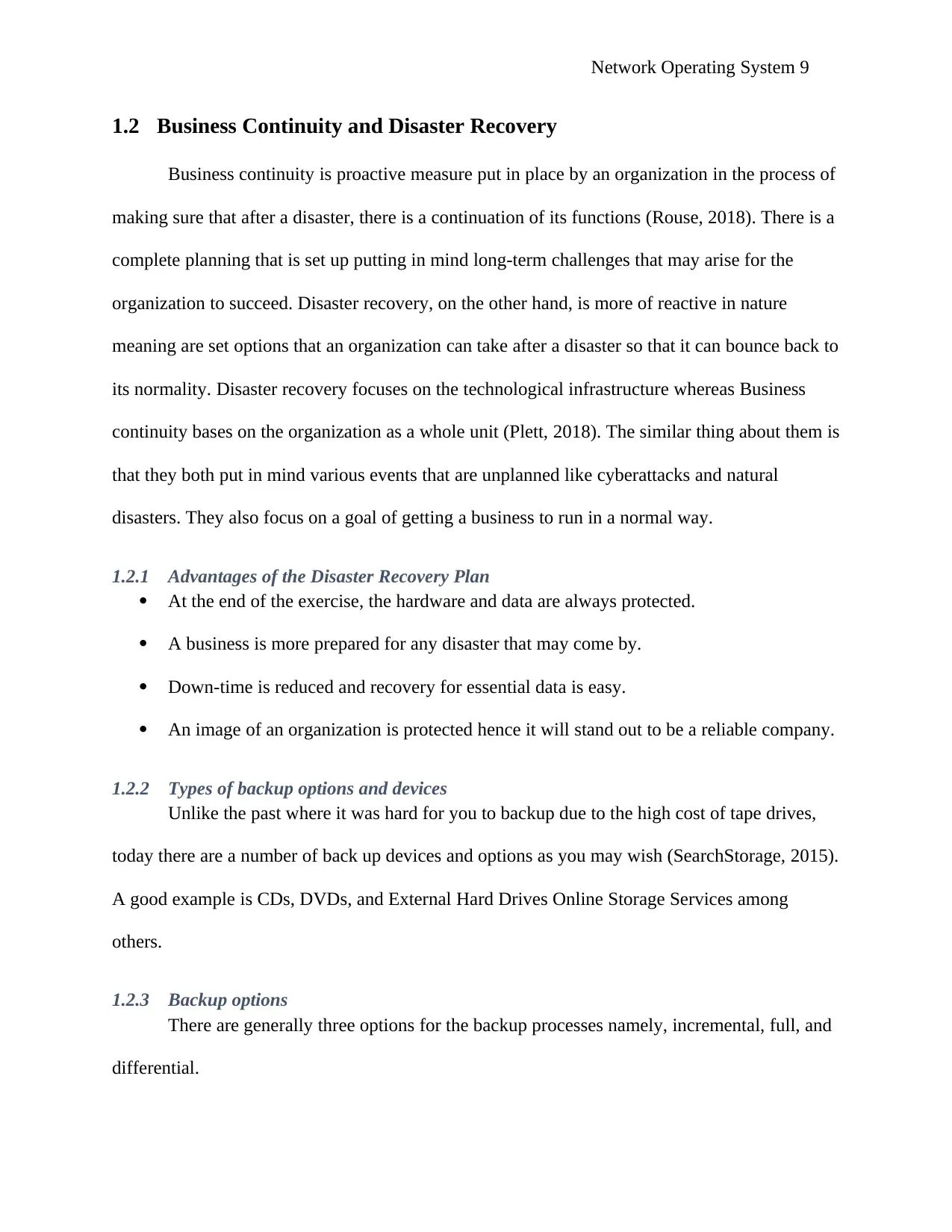
Network Operating System 9
1.2 Business Continuity and Disaster Recovery
Business continuity is proactive measure put in place by an organization in the process of
making sure that after a disaster, there is a continuation of its functions (Rouse, 2018). There is a
complete planning that is set up putting in mind long-term challenges that may arise for the
organization to succeed. Disaster recovery, on the other hand, is more of reactive in nature
meaning are set options that an organization can take after a disaster so that it can bounce back to
its normality. Disaster recovery focuses on the technological infrastructure whereas Business
continuity bases on the organization as a whole unit (Plett, 2018). The similar thing about them is
that they both put in mind various events that are unplanned like cyberattacks and natural
disasters. They also focus on a goal of getting a business to run in a normal way.
1.2.1 Advantages of the Disaster Recovery Plan
At the end of the exercise, the hardware and data are always protected.
A business is more prepared for any disaster that may come by.
Down-time is reduced and recovery for essential data is easy.
An image of an organization is protected hence it will stand out to be a reliable company.
1.2.2 Types of backup options and devices
Unlike the past where it was hard for you to backup due to the high cost of tape drives,
today there are a number of back up devices and options as you may wish (SearchStorage, 2015).
A good example is CDs, DVDs, and External Hard Drives Online Storage Services among
others.
1.2.3 Backup options
There are generally three options for the backup processes namely, incremental, full, and
differential.
1.2 Business Continuity and Disaster Recovery
Business continuity is proactive measure put in place by an organization in the process of
making sure that after a disaster, there is a continuation of its functions (Rouse, 2018). There is a
complete planning that is set up putting in mind long-term challenges that may arise for the
organization to succeed. Disaster recovery, on the other hand, is more of reactive in nature
meaning are set options that an organization can take after a disaster so that it can bounce back to
its normality. Disaster recovery focuses on the technological infrastructure whereas Business
continuity bases on the organization as a whole unit (Plett, 2018). The similar thing about them is
that they both put in mind various events that are unplanned like cyberattacks and natural
disasters. They also focus on a goal of getting a business to run in a normal way.
1.2.1 Advantages of the Disaster Recovery Plan
At the end of the exercise, the hardware and data are always protected.
A business is more prepared for any disaster that may come by.
Down-time is reduced and recovery for essential data is easy.
An image of an organization is protected hence it will stand out to be a reliable company.
1.2.2 Types of backup options and devices
Unlike the past where it was hard for you to backup due to the high cost of tape drives,
today there are a number of back up devices and options as you may wish (SearchStorage, 2015).
A good example is CDs, DVDs, and External Hard Drives Online Storage Services among
others.
1.2.3 Backup options
There are generally three options for the backup processes namely, incremental, full, and
differential.

Network Operating System 10
Full Backup
Here, a full copy of all your data set is backed up. There is a lot of time taken for this
process hence most organization don’t go for it. The number of tapes required is also the reason
as to why it is not mostly used.
Incremental Backup
They came as a way to reduce the time taken while doing a full backup. It is known to
only backup the data that changes during the previous backup (Slater, 2015). This type has the
disadvantage of time consuming when trying to restore and in the process, if one tape happens to
be damaged or missing, there cannot be a full restoration.
Differential Backup
This type is similar to incremental in a way that at the start, there is a full backup but as
the process continues, only data that has changed is backed up (Meena, 2017). This type contains
all the data that has changed considering the last backup, unlike incremental backup where it
only contains data that has transformed since the preceding backup. This type also has the
advantage of shorter restore time compared to incremental backup.
Synthetic full backup
This is known to be a variation of the incremental backup where by it takes data step by
step unlike the original incremental where a full backup is taken and a sequence in the
incremental backup (Stanek, 2018). The backup server in this type has the capability to produce
a full backup. The full backup is combined with data that comes from the incremental backup to
produce a full backup. It has an advantage of reduced restore time. There is also decreased time
taken to backup.
Increased-forever backup
Full Backup
Here, a full copy of all your data set is backed up. There is a lot of time taken for this
process hence most organization don’t go for it. The number of tapes required is also the reason
as to why it is not mostly used.
Incremental Backup
They came as a way to reduce the time taken while doing a full backup. It is known to
only backup the data that changes during the previous backup (Slater, 2015). This type has the
disadvantage of time consuming when trying to restore and in the process, if one tape happens to
be damaged or missing, there cannot be a full restoration.
Differential Backup
This type is similar to incremental in a way that at the start, there is a full backup but as
the process continues, only data that has changed is backed up (Meena, 2017). This type contains
all the data that has changed considering the last backup, unlike incremental backup where it
only contains data that has transformed since the preceding backup. This type also has the
advantage of shorter restore time compared to incremental backup.
Synthetic full backup
This is known to be a variation of the incremental backup where by it takes data step by
step unlike the original incremental where a full backup is taken and a sequence in the
incremental backup (Stanek, 2018). The backup server in this type has the capability to produce
a full backup. The full backup is combined with data that comes from the incremental backup to
produce a full backup. It has an advantage of reduced restore time. There is also decreased time
taken to backup.
Increased-forever backup
Secure Best Marks with AI Grader
Need help grading? Try our AI Grader for instant feedback on your assignments.
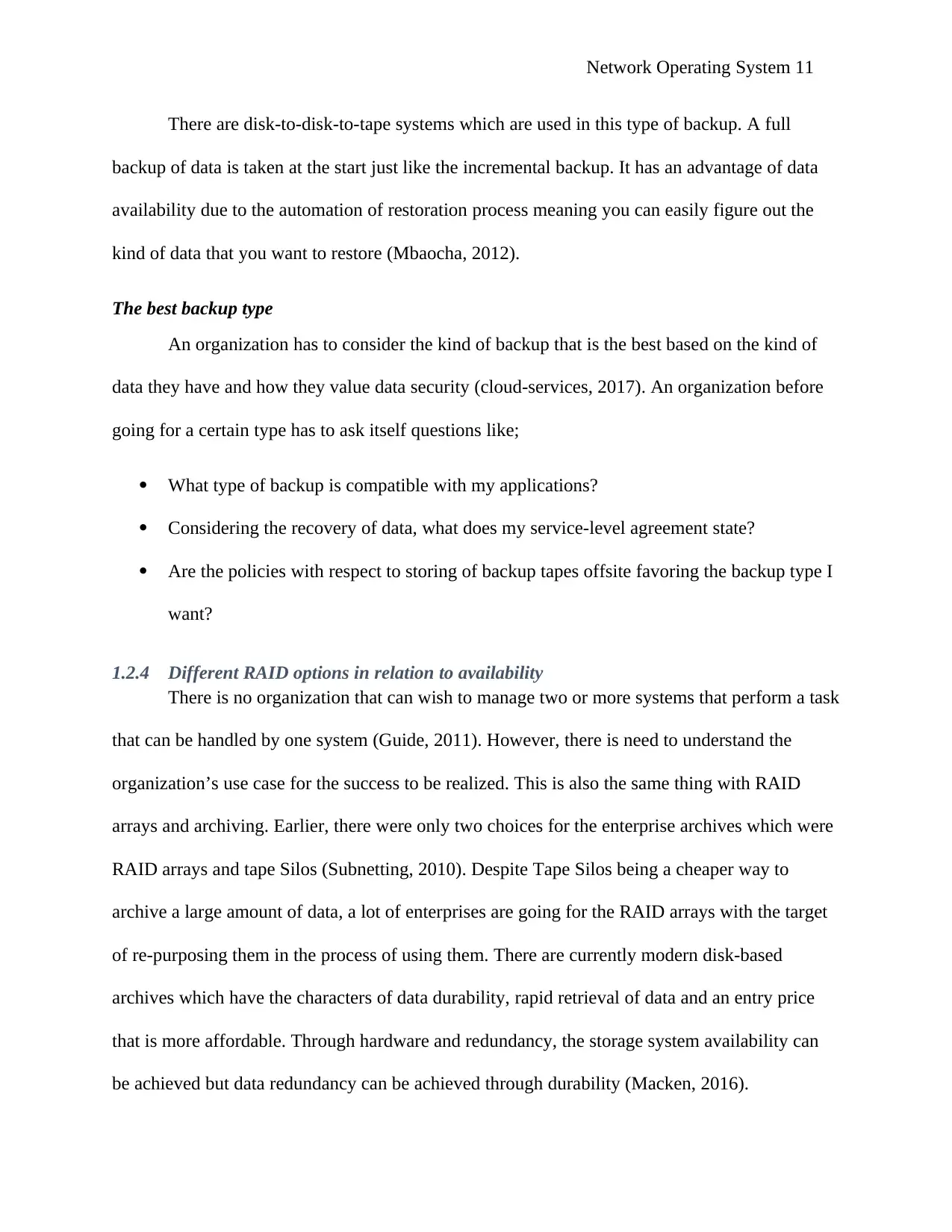
Network Operating System 11
There are disk-to-disk-to-tape systems which are used in this type of backup. A full
backup of data is taken at the start just like the incremental backup. It has an advantage of data
availability due to the automation of restoration process meaning you can easily figure out the
kind of data that you want to restore (Mbaocha, 2012).
The best backup type
An organization has to consider the kind of backup that is the best based on the kind of
data they have and how they value data security (cloud-services, 2017). An organization before
going for a certain type has to ask itself questions like;
What type of backup is compatible with my applications?
Considering the recovery of data, what does my service-level agreement state?
Are the policies with respect to storing of backup tapes offsite favoring the backup type I
want?
1.2.4 Different RAID options in relation to availability
There is no organization that can wish to manage two or more systems that perform a task
that can be handled by one system (Guide, 2011). However, there is need to understand the
organization’s use case for the success to be realized. This is also the same thing with RAID
arrays and archiving. Earlier, there were only two choices for the enterprise archives which were
RAID arrays and tape Silos (Subnetting, 2010). Despite Tape Silos being a cheaper way to
archive a large amount of data, a lot of enterprises are going for the RAID arrays with the target
of re-purposing them in the process of using them. There are currently modern disk-based
archives which have the characters of data durability, rapid retrieval of data and an entry price
that is more affordable. Through hardware and redundancy, the storage system availability can
be achieved but data redundancy can be achieved through durability (Macken, 2016).
There are disk-to-disk-to-tape systems which are used in this type of backup. A full
backup of data is taken at the start just like the incremental backup. It has an advantage of data
availability due to the automation of restoration process meaning you can easily figure out the
kind of data that you want to restore (Mbaocha, 2012).
The best backup type
An organization has to consider the kind of backup that is the best based on the kind of
data they have and how they value data security (cloud-services, 2017). An organization before
going for a certain type has to ask itself questions like;
What type of backup is compatible with my applications?
Considering the recovery of data, what does my service-level agreement state?
Are the policies with respect to storing of backup tapes offsite favoring the backup type I
want?
1.2.4 Different RAID options in relation to availability
There is no organization that can wish to manage two or more systems that perform a task
that can be handled by one system (Guide, 2011). However, there is need to understand the
organization’s use case for the success to be realized. This is also the same thing with RAID
arrays and archiving. Earlier, there were only two choices for the enterprise archives which were
RAID arrays and tape Silos (Subnetting, 2010). Despite Tape Silos being a cheaper way to
archive a large amount of data, a lot of enterprises are going for the RAID arrays with the target
of re-purposing them in the process of using them. There are currently modern disk-based
archives which have the characters of data durability, rapid retrieval of data and an entry price
that is more affordable. Through hardware and redundancy, the storage system availability can
be achieved but data redundancy can be achieved through durability (Macken, 2016).
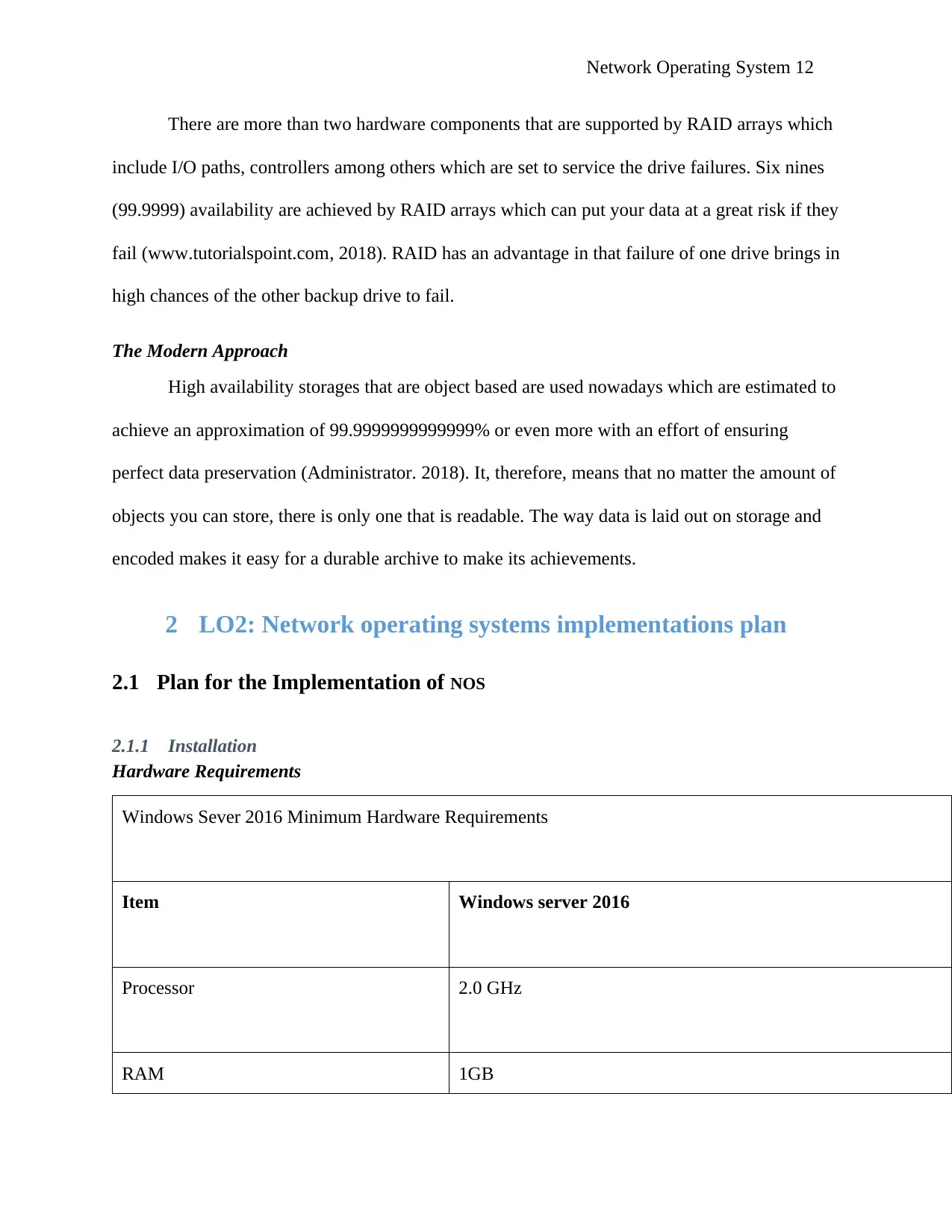
Network Operating System 12
There are more than two hardware components that are supported by RAID arrays which
include I/O paths, controllers among others which are set to service the drive failures. Six nines
(99.9999) availability are achieved by RAID arrays which can put your data at a great risk if they
fail (www.tutorialspoint.com, 2018). RAID has an advantage in that failure of one drive brings in
high chances of the other backup drive to fail.
The Modern Approach
High availability storages that are object based are used nowadays which are estimated to
achieve an approximation of 99.9999999999999% or even more with an effort of ensuring
perfect data preservation (Administrator. 2018). It, therefore, means that no matter the amount of
objects you can store, there is only one that is readable. The way data is laid out on storage and
encoded makes it easy for a durable archive to make its achievements.
2 LO2: Network operating systems implementations plan
2.1 Plan for the Implementation of NOS
2.1.1 Installation
Hardware Requirements
Windows Sever 2016 Minimum Hardware Requirements
Item Windows server 2016
Processor 2.0 GHz
RAM 1GB
There are more than two hardware components that are supported by RAID arrays which
include I/O paths, controllers among others which are set to service the drive failures. Six nines
(99.9999) availability are achieved by RAID arrays which can put your data at a great risk if they
fail (www.tutorialspoint.com, 2018). RAID has an advantage in that failure of one drive brings in
high chances of the other backup drive to fail.
The Modern Approach
High availability storages that are object based are used nowadays which are estimated to
achieve an approximation of 99.9999999999999% or even more with an effort of ensuring
perfect data preservation (Administrator. 2018). It, therefore, means that no matter the amount of
objects you can store, there is only one that is readable. The way data is laid out on storage and
encoded makes it easy for a durable archive to make its achievements.
2 LO2: Network operating systems implementations plan
2.1 Plan for the Implementation of NOS
2.1.1 Installation
Hardware Requirements
Windows Sever 2016 Minimum Hardware Requirements
Item Windows server 2016
Processor 2.0 GHz
RAM 1GB
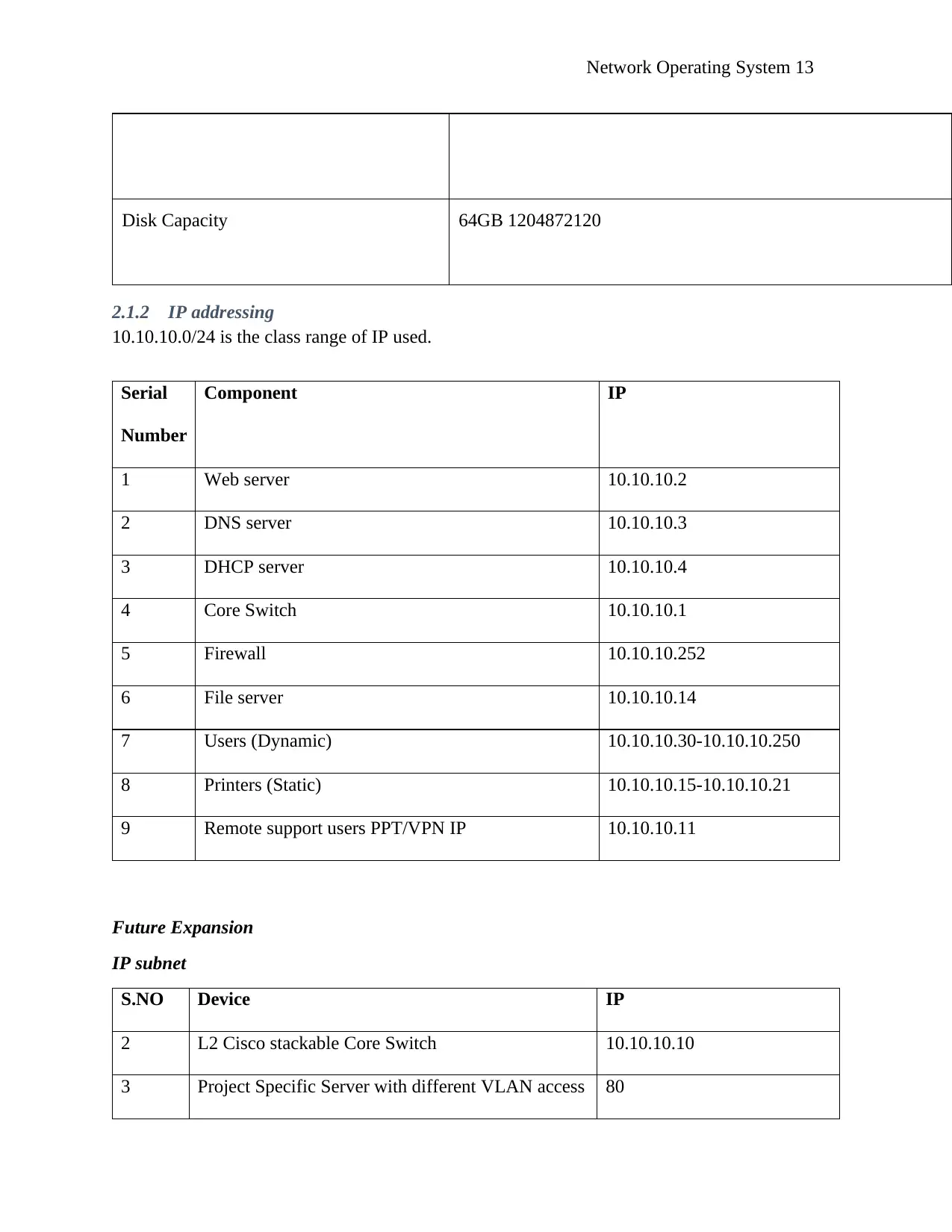
Network Operating System 13
Disk Capacity 64GB 1204872120
2.1.2 IP addressing
10.10.10.0/24 is the class range of IP used.
Serial
Number
Component IP
1 Web server 10.10.10.2
2 DNS server 10.10.10.3
3 DHCP server 10.10.10.4
4 Core Switch 10.10.10.1
5 Firewall 10.10.10.252
6 File server 10.10.10.14
7 Users (Dynamic) 10.10.10.30-10.10.10.250
8 Printers (Static) 10.10.10.15-10.10.10.21
9 Remote support users PPT/VPN IP 10.10.10.11
Future Expansion
IP subnet
S.NO Device IP
2 L2 Cisco stackable Core Switch 10.10.10.10
3 Project Specific Server with different VLAN access 80
Disk Capacity 64GB 1204872120
2.1.2 IP addressing
10.10.10.0/24 is the class range of IP used.
Serial
Number
Component IP
1 Web server 10.10.10.2
2 DNS server 10.10.10.3
3 DHCP server 10.10.10.4
4 Core Switch 10.10.10.1
5 Firewall 10.10.10.252
6 File server 10.10.10.14
7 Users (Dynamic) 10.10.10.30-10.10.10.250
8 Printers (Static) 10.10.10.15-10.10.10.21
9 Remote support users PPT/VPN IP 10.10.10.11
Future Expansion
IP subnet
S.NO Device IP
2 L2 Cisco stackable Core Switch 10.10.10.10
3 Project Specific Server with different VLAN access 80
Paraphrase This Document
Need a fresh take? Get an instant paraphrase of this document with our AI Paraphraser
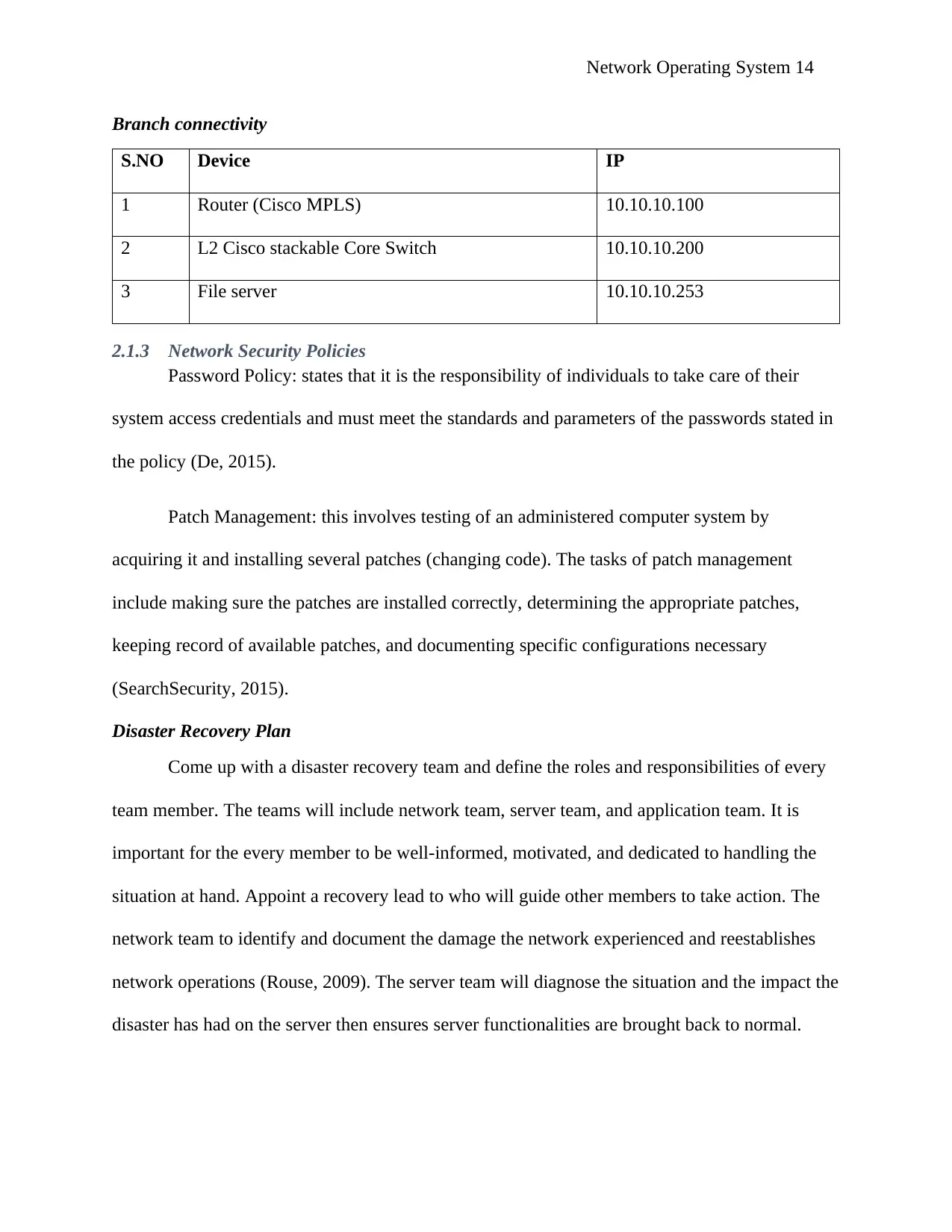
Network Operating System 14
Branch connectivity
S.NO Device IP
1 Router (Cisco MPLS) 10.10.10.100
2 L2 Cisco stackable Core Switch 10.10.10.200
3 File server 10.10.10.253
2.1.3 Network Security Policies
Password Policy: states that it is the responsibility of individuals to take care of their
system access credentials and must meet the standards and parameters of the passwords stated in
the policy (De, 2015).
Patch Management: this involves testing of an administered computer system by
acquiring it and installing several patches (changing code). The tasks of patch management
include making sure the patches are installed correctly, determining the appropriate patches,
keeping record of available patches, and documenting specific configurations necessary
(SearchSecurity, 2015).
Disaster Recovery Plan
Come up with a disaster recovery team and define the roles and responsibilities of every
team member. The teams will include network team, server team, and application team. It is
important for the every member to be well-informed, motivated, and dedicated to handling the
situation at hand. Appoint a recovery lead to who will guide other members to take action. The
network team to identify and document the damage the network experienced and reestablishes
network operations (Rouse, 2009). The server team will diagnose the situation and the impact the
disaster has had on the server then ensures server functionalities are brought back to normal.
Branch connectivity
S.NO Device IP
1 Router (Cisco MPLS) 10.10.10.100
2 L2 Cisco stackable Core Switch 10.10.10.200
3 File server 10.10.10.253
2.1.3 Network Security Policies
Password Policy: states that it is the responsibility of individuals to take care of their
system access credentials and must meet the standards and parameters of the passwords stated in
the policy (De, 2015).
Patch Management: this involves testing of an administered computer system by
acquiring it and installing several patches (changing code). The tasks of patch management
include making sure the patches are installed correctly, determining the appropriate patches,
keeping record of available patches, and documenting specific configurations necessary
(SearchSecurity, 2015).
Disaster Recovery Plan
Come up with a disaster recovery team and define the roles and responsibilities of every
team member. The teams will include network team, server team, and application team. It is
important for the every member to be well-informed, motivated, and dedicated to handling the
situation at hand. Appoint a recovery lead to who will guide other members to take action. The
network team to identify and document the damage the network experienced and reestablishes
network operations (Rouse, 2009). The server team will diagnose the situation and the impact the
disaster has had on the server then ensures server functionalities are brought back to normal.
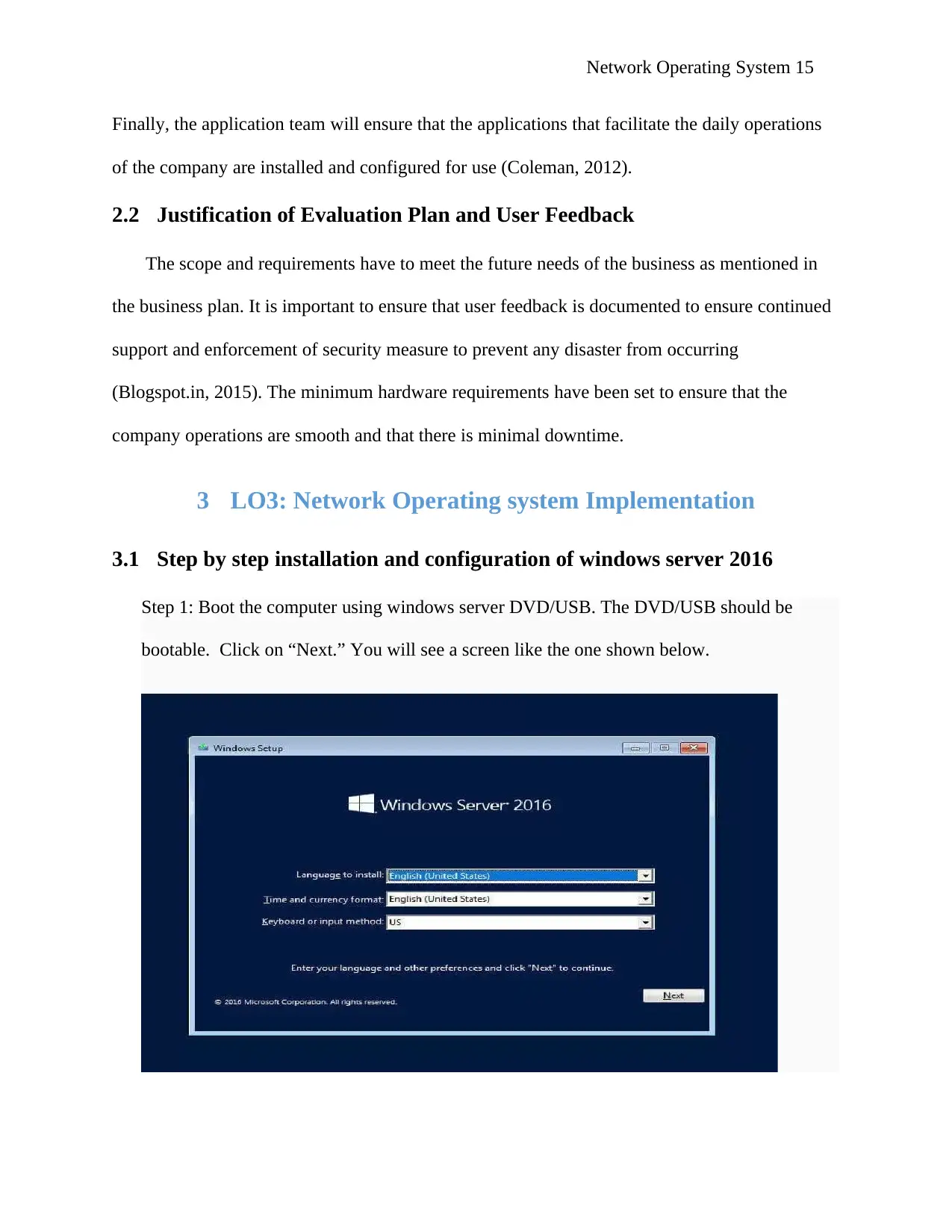
Network Operating System 15
Finally, the application team will ensure that the applications that facilitate the daily operations
of the company are installed and configured for use (Coleman, 2012).
2.2 Justification of Evaluation Plan and User Feedback
The scope and requirements have to meet the future needs of the business as mentioned in
the business plan. It is important to ensure that user feedback is documented to ensure continued
support and enforcement of security measure to prevent any disaster from occurring
(Blogspot.in, 2015). The minimum hardware requirements have been set to ensure that the
company operations are smooth and that there is minimal downtime.
3 LO3: Network Operating system Implementation
3.1 Step by step installation and configuration of windows server 2016
Step 1: Boot the computer using windows server DVD/USB. The DVD/USB should be
bootable. Click on “Next.” You will see a screen like the one shown below.
Finally, the application team will ensure that the applications that facilitate the daily operations
of the company are installed and configured for use (Coleman, 2012).
2.2 Justification of Evaluation Plan and User Feedback
The scope and requirements have to meet the future needs of the business as mentioned in
the business plan. It is important to ensure that user feedback is documented to ensure continued
support and enforcement of security measure to prevent any disaster from occurring
(Blogspot.in, 2015). The minimum hardware requirements have been set to ensure that the
company operations are smooth and that there is minimal downtime.
3 LO3: Network Operating system Implementation
3.1 Step by step installation and configuration of windows server 2016
Step 1: Boot the computer using windows server DVD/USB. The DVD/USB should be
bootable. Click on “Next.” You will see a screen like the one shown below.
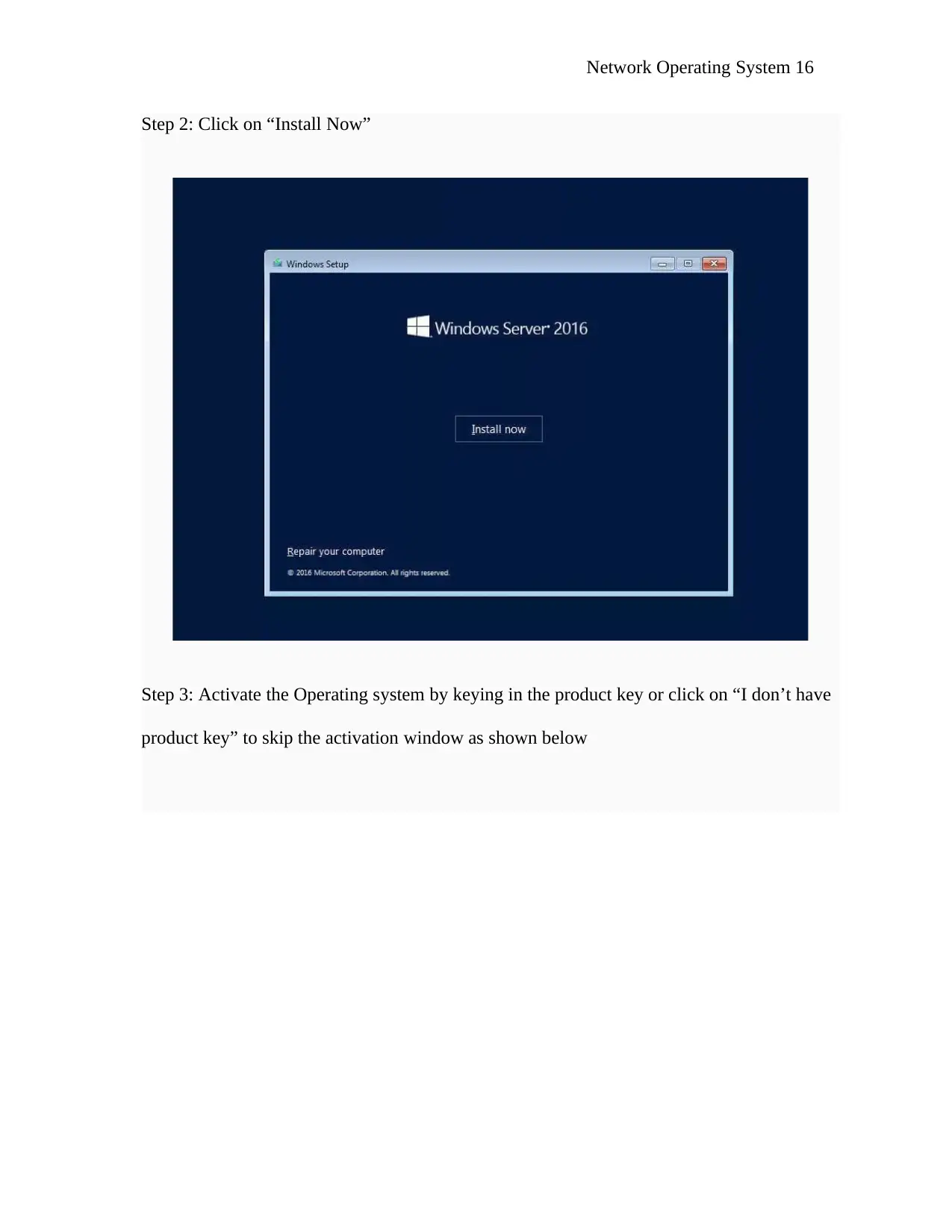
Network Operating System 16
Step 2: Click on “Install Now”
Step 3: Activate the Operating system by keying in the product key or click on “I don’t have
product key” to skip the activation window as shown below
Step 2: Click on “Install Now”
Step 3: Activate the Operating system by keying in the product key or click on “I don’t have
product key” to skip the activation window as shown below
Secure Best Marks with AI Grader
Need help grading? Try our AI Grader for instant feedback on your assignments.
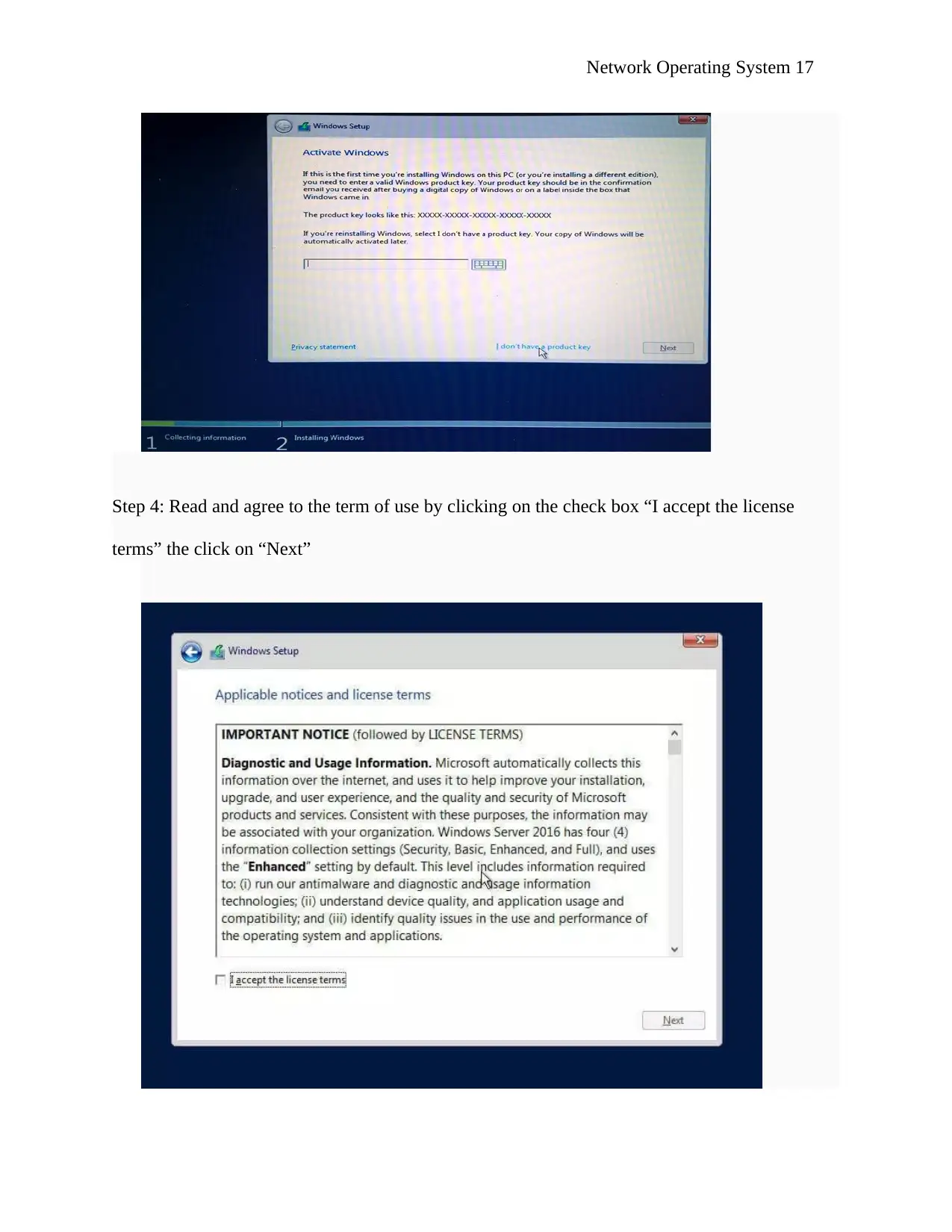
Network Operating System 17
Step 4: Read and agree to the term of use by clicking on the check box “I accept the license
terms” the click on “Next”
Step 4: Read and agree to the term of use by clicking on the check box “I accept the license
terms” the click on “Next”
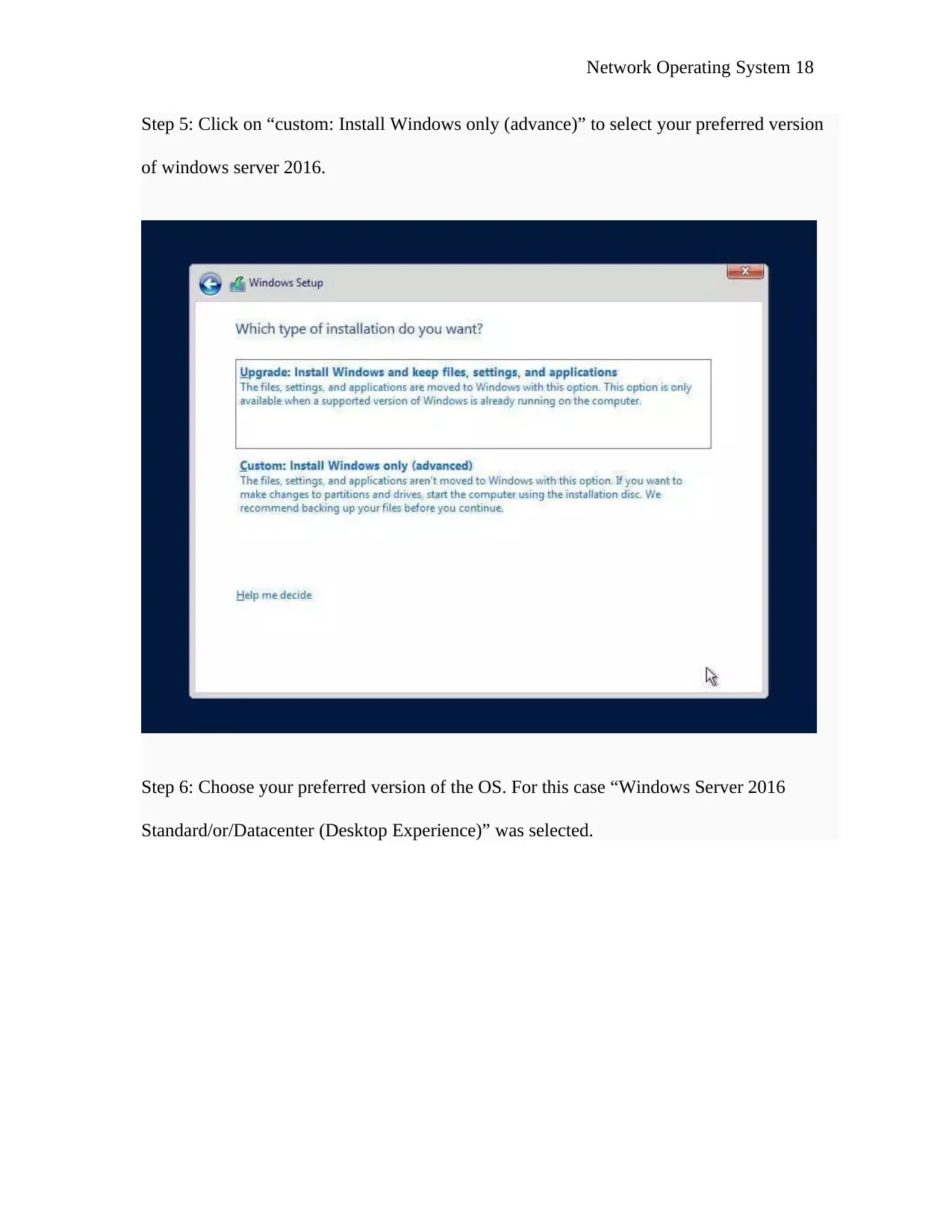
Network Operating System 18
Step 5: Click on “custom: Install Windows only (advance)” to select your preferred version
of windows server 2016.
Step 6: Choose your preferred version of the OS. For this case “Windows Server 2016
Standard/or/Datacenter (Desktop Experience)” was selected.
Step 5: Click on “custom: Install Windows only (advance)” to select your preferred version
of windows server 2016.
Step 6: Choose your preferred version of the OS. For this case “Windows Server 2016
Standard/or/Datacenter (Desktop Experience)” was selected.
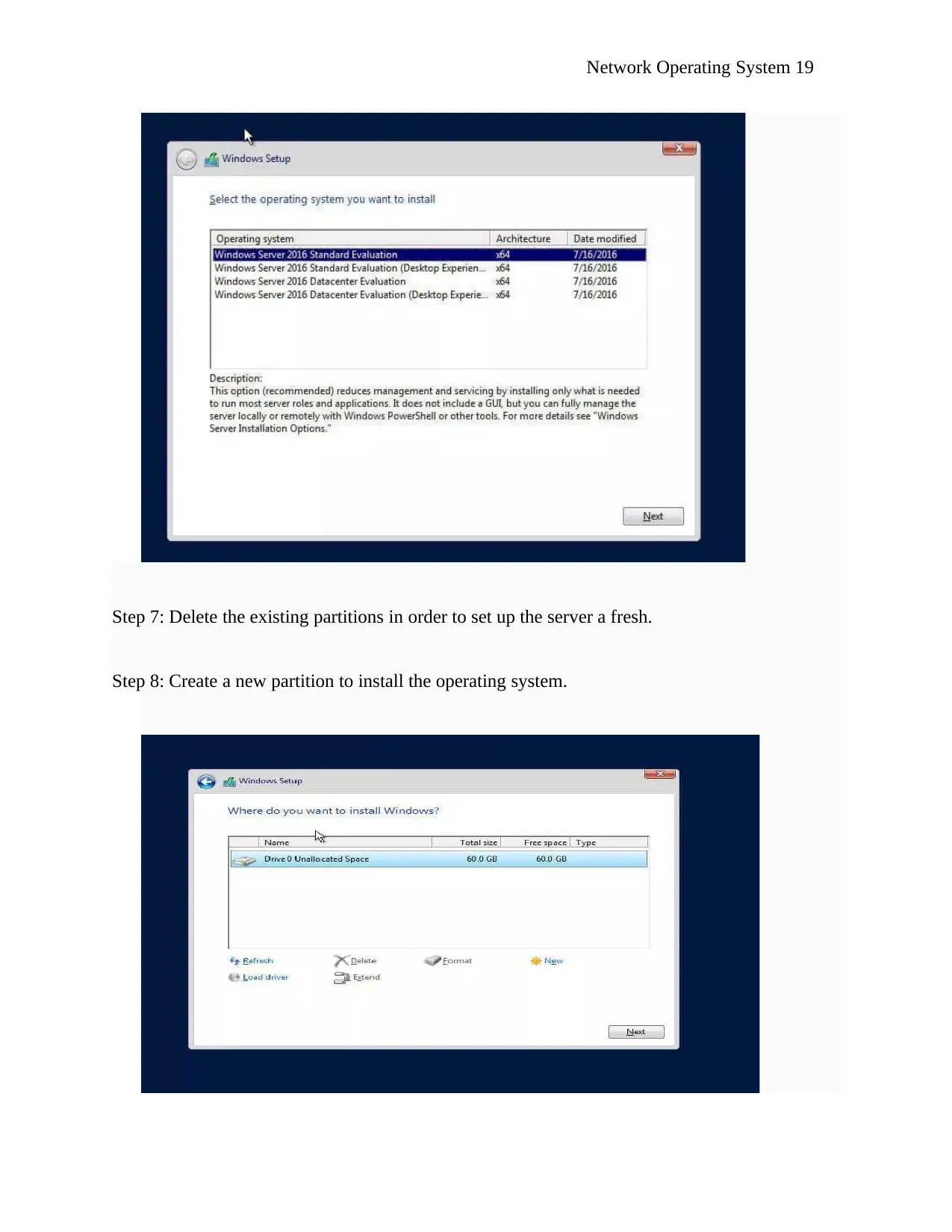
Network Operating System 19
Step 7: Delete the existing partitions in order to set up the server a fresh.
Step 8: Create a new partition to install the operating system.
Step 7: Delete the existing partitions in order to set up the server a fresh.
Step 8: Create a new partition to install the operating system.
Paraphrase This Document
Need a fresh take? Get an instant paraphrase of this document with our AI Paraphraser
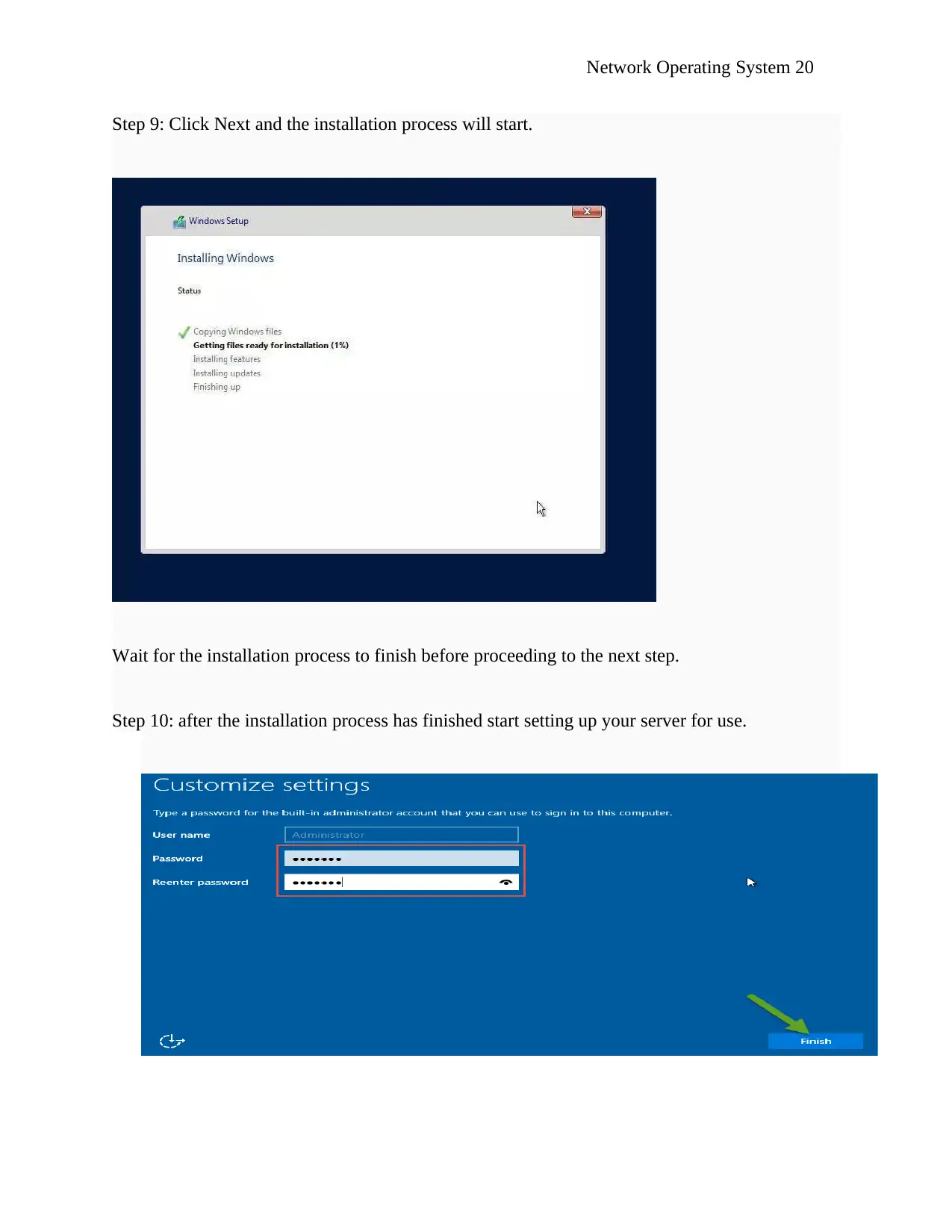
Network Operating System 20
Step 9: Click Next and the installation process will start.
Wait for the installation process to finish before proceeding to the next step.
Step 10: after the installation process has finished start setting up your server for use.
Step 9: Click Next and the installation process will start.
Wait for the installation process to finish before proceeding to the next step.
Step 10: after the installation process has finished start setting up your server for use.

Network Operating System 21
Set Administrator password and click on “finish”
Step 11: Press control+Alt+Delete to bring up the login screen.
Press [CTRL-ALT-DEL] to bring up the login screen
Step 12: Login in to the server by entering the administrator password.
Type in the password and press enter and you are good to go.
Set Administrator password and click on “finish”
Step 11: Press control+Alt+Delete to bring up the login screen.
Press [CTRL-ALT-DEL] to bring up the login screen
Step 12: Login in to the server by entering the administrator password.
Type in the password and press enter and you are good to go.
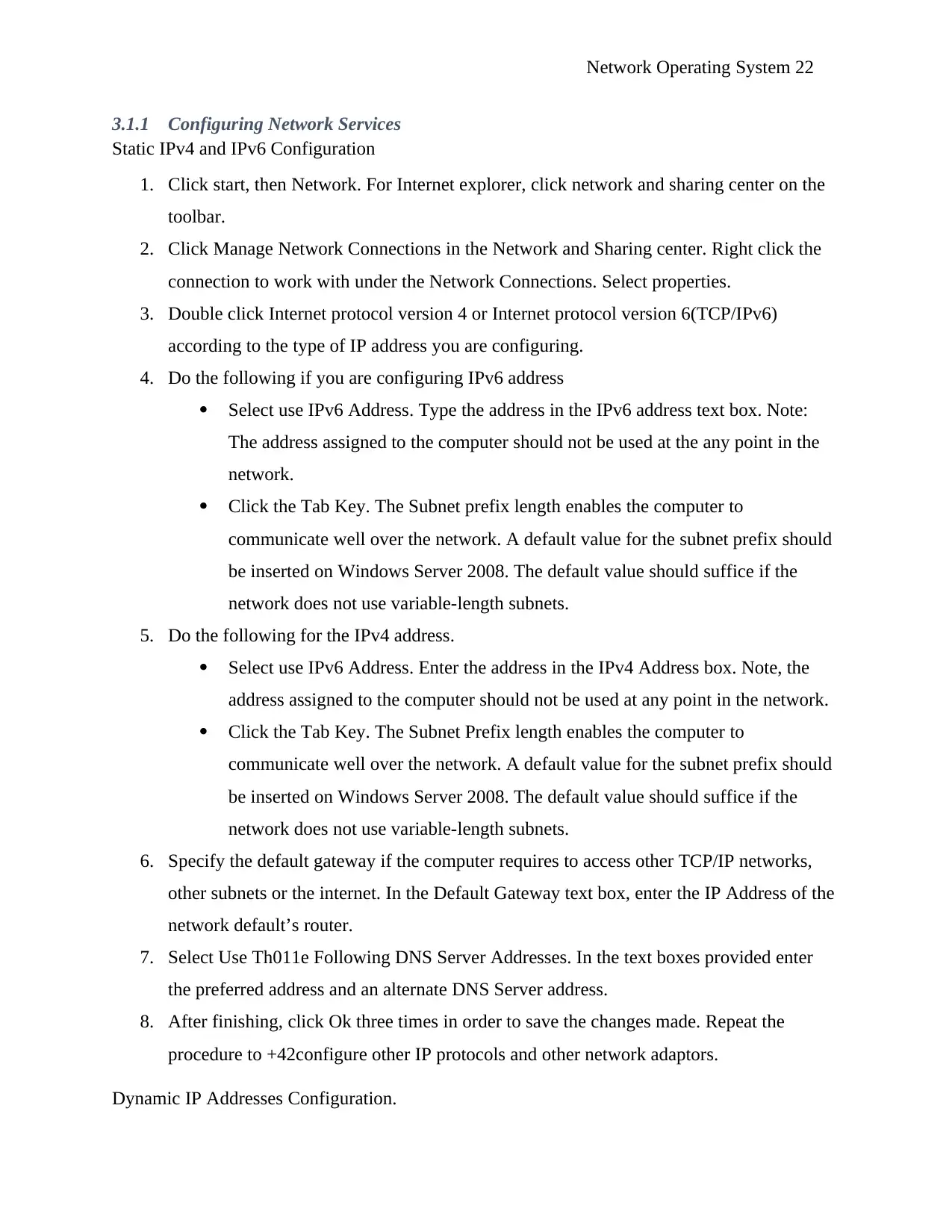
Network Operating System 22
3.1.1 Configuring Network Services
Static IPv4 and IPv6 Configuration
1. Click start, then Network. For Internet explorer, click network and sharing center on the
toolbar.
2. Click Manage Network Connections in the Network and Sharing center. Right click the
connection to work with under the Network Connections. Select properties.
3. Double click Internet protocol version 4 or Internet protocol version 6(TCP/IPv6)
according to the type of IP address you are configuring.
4. Do the following if you are configuring IPv6 address
Select use IPv6 Address. Type the address in the IPv6 address text box. Note:
The address assigned to the computer should not be used at the any point in the
network.
Click the Tab Key. The Subnet prefix length enables the computer to
communicate well over the network. A default value for the subnet prefix should
be inserted on Windows Server 2008. The default value should suffice if the
network does not use variable-length subnets.
5. Do the following for the IPv4 address.
Select use IPv6 Address. Enter the address in the IPv4 Address box. Note, the
address assigned to the computer should not be used at any point in the network.
Click the Tab Key. The Subnet Prefix length enables the computer to
communicate well over the network. A default value for the subnet prefix should
be inserted on Windows Server 2008. The default value should suffice if the
network does not use variable-length subnets.
6. Specify the default gateway if the computer requires to access other TCP/IP networks,
other subnets or the internet. In the Default Gateway text box, enter the IP Address of the
network default’s router.
7. Select Use Th011e Following DNS Server Addresses. In the text boxes provided enter
the preferred address and an alternate DNS Server address.
8. After finishing, click Ok three times in order to save the changes made. Repeat the
procedure to +42configure other IP protocols and other network adaptors.
Dynamic IP Addresses Configuration.
3.1.1 Configuring Network Services
Static IPv4 and IPv6 Configuration
1. Click start, then Network. For Internet explorer, click network and sharing center on the
toolbar.
2. Click Manage Network Connections in the Network and Sharing center. Right click the
connection to work with under the Network Connections. Select properties.
3. Double click Internet protocol version 4 or Internet protocol version 6(TCP/IPv6)
according to the type of IP address you are configuring.
4. Do the following if you are configuring IPv6 address
Select use IPv6 Address. Type the address in the IPv6 address text box. Note:
The address assigned to the computer should not be used at the any point in the
network.
Click the Tab Key. The Subnet prefix length enables the computer to
communicate well over the network. A default value for the subnet prefix should
be inserted on Windows Server 2008. The default value should suffice if the
network does not use variable-length subnets.
5. Do the following for the IPv4 address.
Select use IPv6 Address. Enter the address in the IPv4 Address box. Note, the
address assigned to the computer should not be used at any point in the network.
Click the Tab Key. The Subnet Prefix length enables the computer to
communicate well over the network. A default value for the subnet prefix should
be inserted on Windows Server 2008. The default value should suffice if the
network does not use variable-length subnets.
6. Specify the default gateway if the computer requires to access other TCP/IP networks,
other subnets or the internet. In the Default Gateway text box, enter the IP Address of the
network default’s router.
7. Select Use Th011e Following DNS Server Addresses. In the text boxes provided enter
the preferred address and an alternate DNS Server address.
8. After finishing, click Ok three times in order to save the changes made. Repeat the
procedure to +42configure other IP protocols and other network adaptors.
Dynamic IP Addresses Configuration.
Secure Best Marks with AI Grader
Need help grading? Try our AI Grader for instant feedback on your assignments.
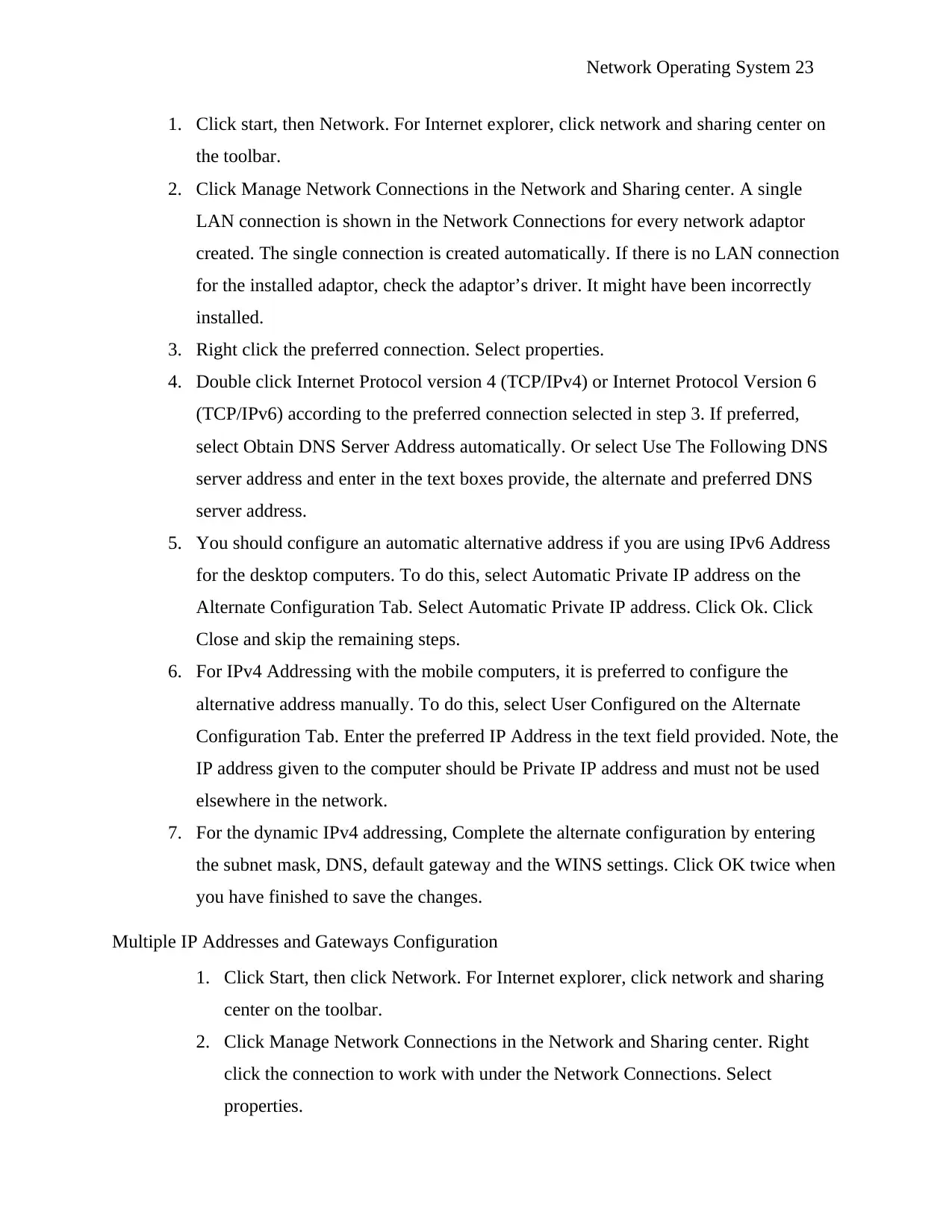
Network Operating System 23
1. Click start, then Network. For Internet explorer, click network and sharing center on
the toolbar.
2. Click Manage Network Connections in the Network and Sharing center. A single
LAN connection is shown in the Network Connections for every network adaptor
created. The single connection is created automatically. If there is no LAN connection
for the installed adaptor, check the adaptor’s driver. It might have been incorrectly
installed.
3. Right click the preferred connection. Select properties.
4. Double click Internet Protocol version 4 (TCP/IPv4) or Internet Protocol Version 6
(TCP/IPv6) according to the preferred connection selected in step 3. If preferred,
select Obtain DNS Server Address automatically. Or select Use The Following DNS
server address and enter in the text boxes provide, the alternate and preferred DNS
server address.
5. You should configure an automatic alternative address if you are using IPv6 Address
for the desktop computers. To do this, select Automatic Private IP address on the
Alternate Configuration Tab. Select Automatic Private IP address. Click Ok. Click
Close and skip the remaining steps.
6. For IPv4 Addressing with the mobile computers, it is preferred to configure the
alternative address manually. To do this, select User Configured on the Alternate
Configuration Tab. Enter the preferred IP Address in the text field provided. Note, the
IP address given to the computer should be Private IP address and must not be used
elsewhere in the network.
7. For the dynamic IPv4 addressing, Complete the alternate configuration by entering
the subnet mask, DNS, default gateway and the WINS settings. Click OK twice when
you have finished to save the changes.
Multiple IP Addresses and Gateways Configuration
1. Click Start, then click Network. For Internet explorer, click network and sharing
center on the toolbar.
2. Click Manage Network Connections in the Network and Sharing center. Right
click the connection to work with under the Network Connections. Select
properties.
1. Click start, then Network. For Internet explorer, click network and sharing center on
the toolbar.
2. Click Manage Network Connections in the Network and Sharing center. A single
LAN connection is shown in the Network Connections for every network adaptor
created. The single connection is created automatically. If there is no LAN connection
for the installed adaptor, check the adaptor’s driver. It might have been incorrectly
installed.
3. Right click the preferred connection. Select properties.
4. Double click Internet Protocol version 4 (TCP/IPv4) or Internet Protocol Version 6
(TCP/IPv6) according to the preferred connection selected in step 3. If preferred,
select Obtain DNS Server Address automatically. Or select Use The Following DNS
server address and enter in the text boxes provide, the alternate and preferred DNS
server address.
5. You should configure an automatic alternative address if you are using IPv6 Address
for the desktop computers. To do this, select Automatic Private IP address on the
Alternate Configuration Tab. Select Automatic Private IP address. Click Ok. Click
Close and skip the remaining steps.
6. For IPv4 Addressing with the mobile computers, it is preferred to configure the
alternative address manually. To do this, select User Configured on the Alternate
Configuration Tab. Enter the preferred IP Address in the text field provided. Note, the
IP address given to the computer should be Private IP address and must not be used
elsewhere in the network.
7. For the dynamic IPv4 addressing, Complete the alternate configuration by entering
the subnet mask, DNS, default gateway and the WINS settings. Click OK twice when
you have finished to save the changes.
Multiple IP Addresses and Gateways Configuration
1. Click Start, then click Network. For Internet explorer, click network and sharing
center on the toolbar.
2. Click Manage Network Connections in the Network and Sharing center. Right
click the connection to work with under the Network Connections. Select
properties.
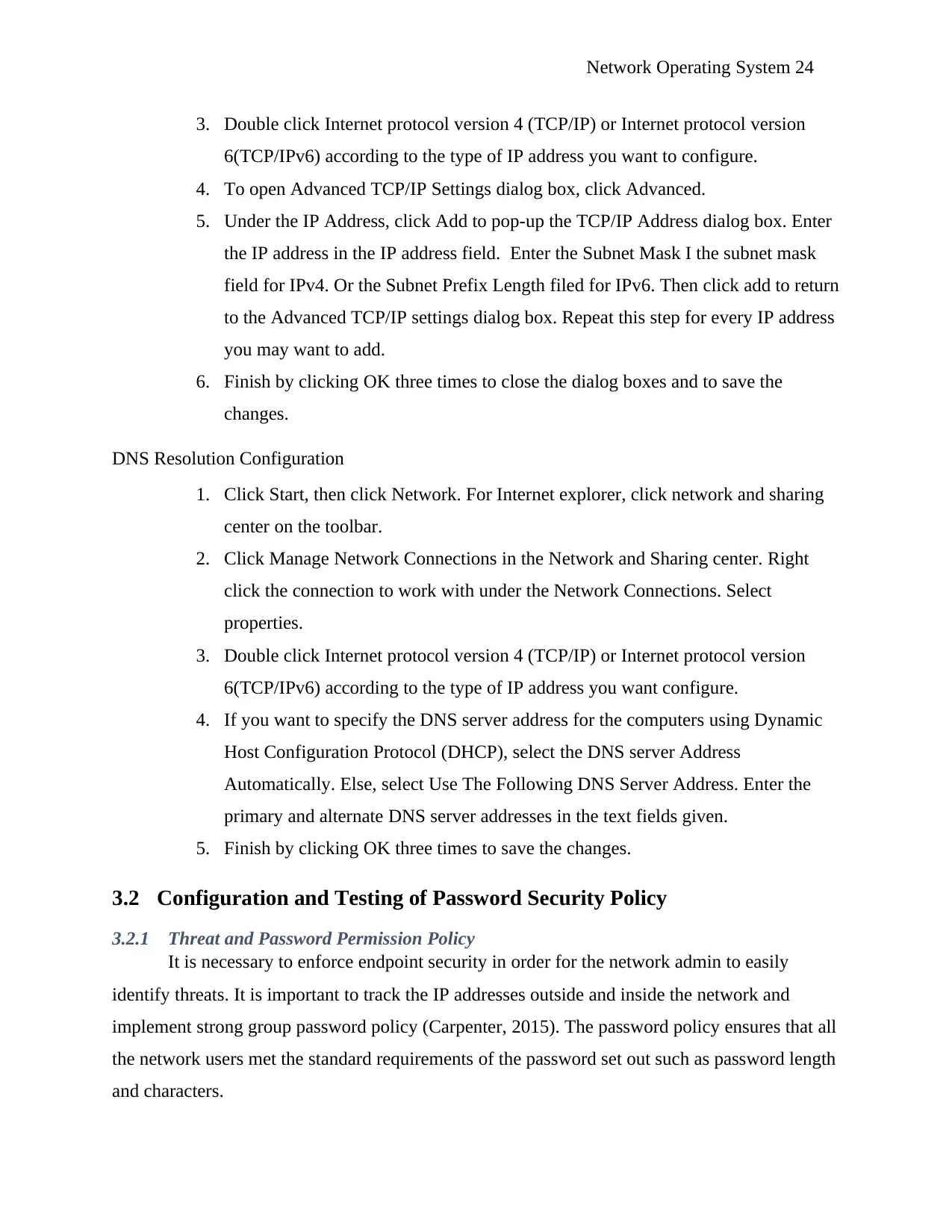
Network Operating System 24
3. Double click Internet protocol version 4 (TCP/IP) or Internet protocol version
6(TCP/IPv6) according to the type of IP address you want to configure.
4. To open Advanced TCP/IP Settings dialog box, click Advanced.
5. Under the IP Address, click Add to pop-up the TCP/IP Address dialog box. Enter
the IP address in the IP address field. Enter the Subnet Mask I the subnet mask
field for IPv4. Or the Subnet Prefix Length filed for IPv6. Then click add to return
to the Advanced TCP/IP settings dialog box. Repeat this step for every IP address
you may want to add.
6. Finish by clicking OK three times to close the dialog boxes and to save the
changes.
DNS Resolution Configuration
1. Click Start, then click Network. For Internet explorer, click network and sharing
center on the toolbar.
2. Click Manage Network Connections in the Network and Sharing center. Right
click the connection to work with under the Network Connections. Select
properties.
3. Double click Internet protocol version 4 (TCP/IP) or Internet protocol version
6(TCP/IPv6) according to the type of IP address you want configure.
4. If you want to specify the DNS server address for the computers using Dynamic
Host Configuration Protocol (DHCP), select the DNS server Address
Automatically. Else, select Use The Following DNS Server Address. Enter the
primary and alternate DNS server addresses in the text fields given.
5. Finish by clicking OK three times to save the changes.
3.2 Configuration and Testing of Password Security Policy
3.2.1 Threat and Password Permission Policy
It is necessary to enforce endpoint security in order for the network admin to easily
identify threats. It is important to track the IP addresses outside and inside the network and
implement strong group password policy (Carpenter, 2015). The password policy ensures that all
the network users met the standard requirements of the password set out such as password length
and characters.
3. Double click Internet protocol version 4 (TCP/IP) or Internet protocol version
6(TCP/IPv6) according to the type of IP address you want to configure.
4. To open Advanced TCP/IP Settings dialog box, click Advanced.
5. Under the IP Address, click Add to pop-up the TCP/IP Address dialog box. Enter
the IP address in the IP address field. Enter the Subnet Mask I the subnet mask
field for IPv4. Or the Subnet Prefix Length filed for IPv6. Then click add to return
to the Advanced TCP/IP settings dialog box. Repeat this step for every IP address
you may want to add.
6. Finish by clicking OK three times to close the dialog boxes and to save the
changes.
DNS Resolution Configuration
1. Click Start, then click Network. For Internet explorer, click network and sharing
center on the toolbar.
2. Click Manage Network Connections in the Network and Sharing center. Right
click the connection to work with under the Network Connections. Select
properties.
3. Double click Internet protocol version 4 (TCP/IP) or Internet protocol version
6(TCP/IPv6) according to the type of IP address you want configure.
4. If you want to specify the DNS server address for the computers using Dynamic
Host Configuration Protocol (DHCP), select the DNS server Address
Automatically. Else, select Use The Following DNS Server Address. Enter the
primary and alternate DNS server addresses in the text fields given.
5. Finish by clicking OK three times to save the changes.
3.2 Configuration and Testing of Password Security Policy
3.2.1 Threat and Password Permission Policy
It is necessary to enforce endpoint security in order for the network admin to easily
identify threats. It is important to track the IP addresses outside and inside the network and
implement strong group password policy (Carpenter, 2015). The password policy ensures that all
the network users met the standard requirements of the password set out such as password length
and characters.
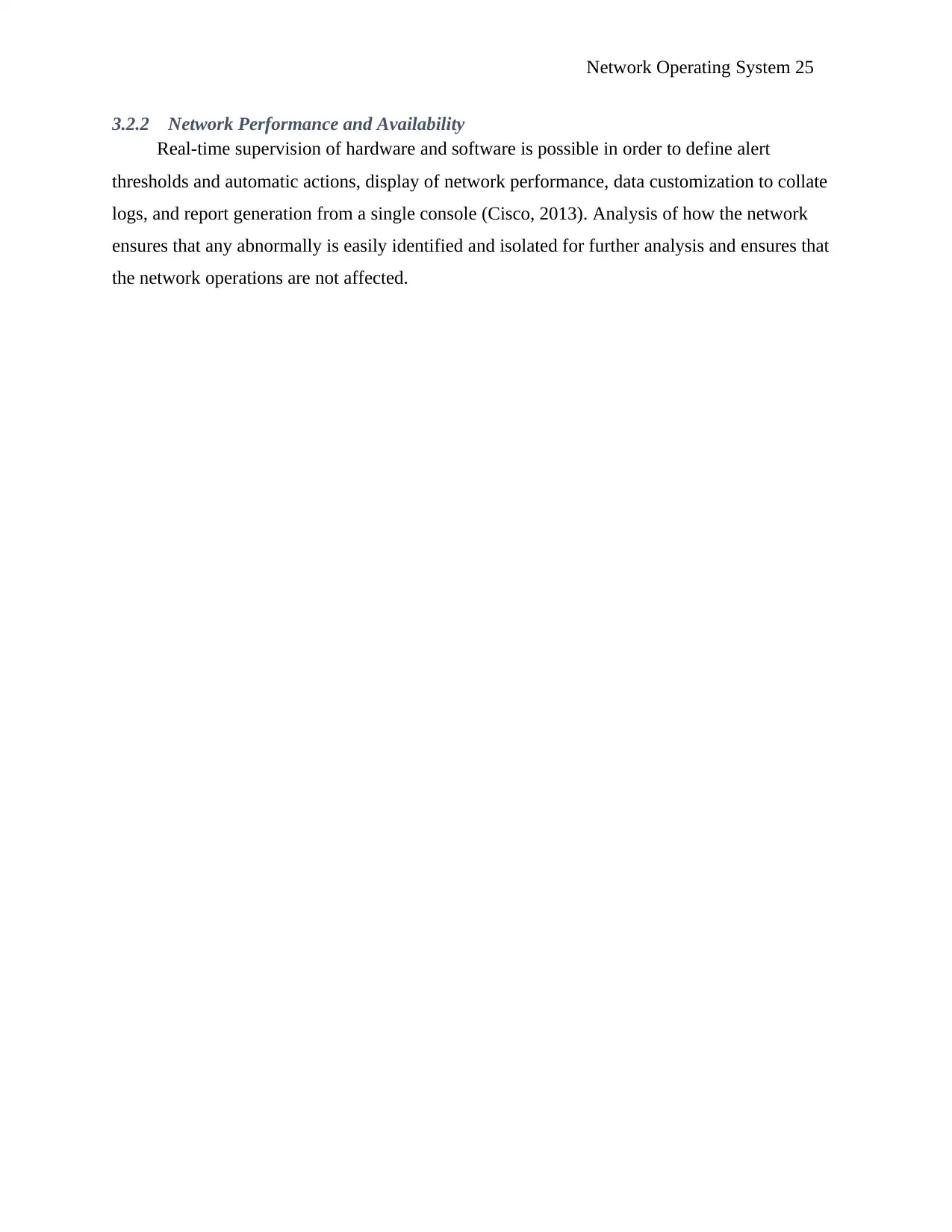
Network Operating System 25
3.2.2 Network Performance and Availability
Real-time supervision of hardware and software is possible in order to define alert
thresholds and automatic actions, display of network performance, data customization to collate
logs, and report generation from a single console (Cisco, 2013). Analysis of how the network
ensures that any abnormally is easily identified and isolated for further analysis and ensures that
the network operations are not affected.
3.2.2 Network Performance and Availability
Real-time supervision of hardware and software is possible in order to define alert
thresholds and automatic actions, display of network performance, data customization to collate
logs, and report generation from a single console (Cisco, 2013). Analysis of how the network
ensures that any abnormally is easily identified and isolated for further analysis and ensures that
the network operations are not affected.
Paraphrase This Document
Need a fresh take? Get an instant paraphrase of this document with our AI Paraphraser
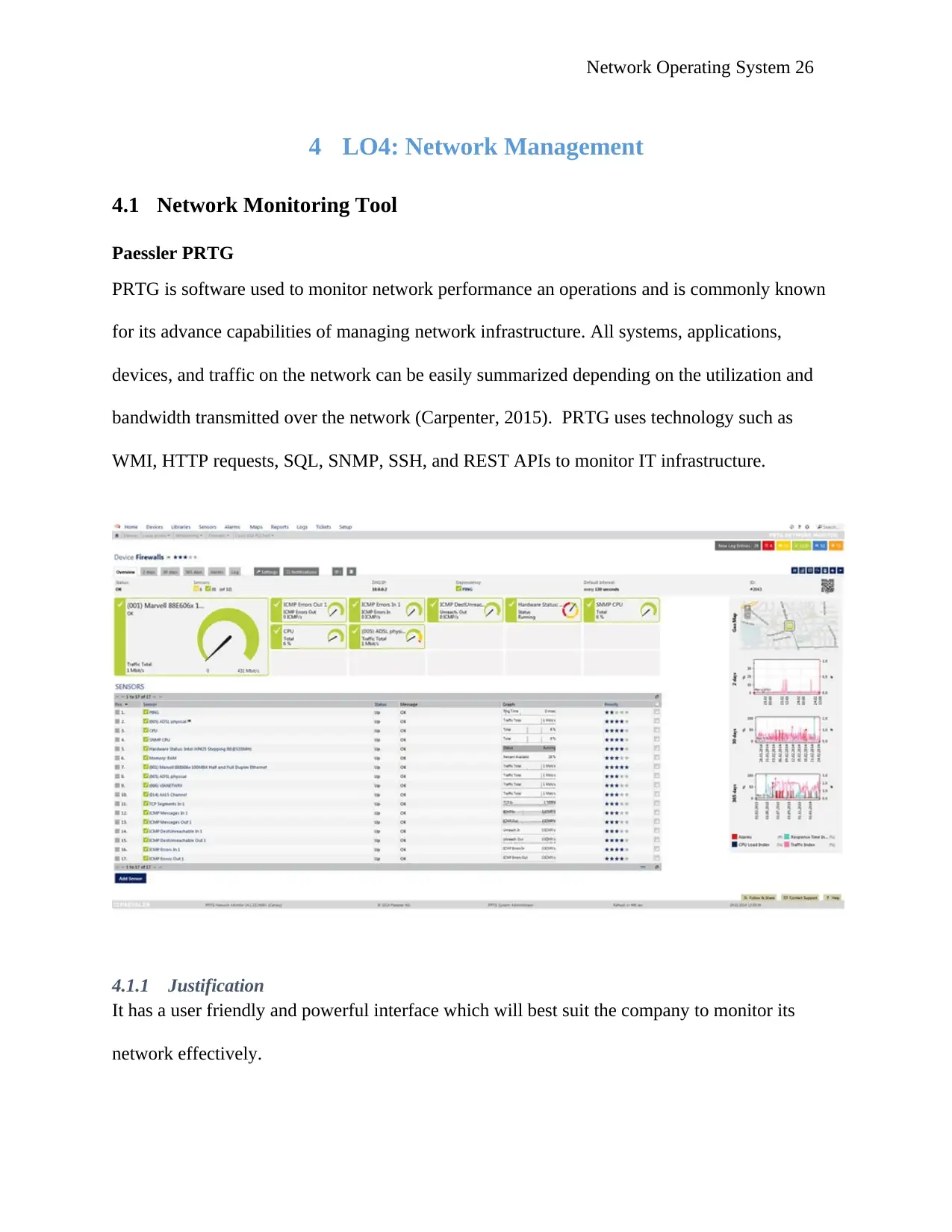
Network Operating System 26
4 LO4: Network Management
4.1 Network Monitoring Tool
Paessler PRTG
PRTG is software used to monitor network performance an operations and is commonly known
for its advance capabilities of managing network infrastructure. All systems, applications,
devices, and traffic on the network can be easily summarized depending on the utilization and
bandwidth transmitted over the network (Carpenter, 2015). PRTG uses technology such as
WMI, HTTP requests, SQL, SNMP, SSH, and REST APIs to monitor IT infrastructure.
4.1.1 Justification
It has a user friendly and powerful interface which will best suit the company to monitor its
network effectively.
4 LO4: Network Management
4.1 Network Monitoring Tool
Paessler PRTG
PRTG is software used to monitor network performance an operations and is commonly known
for its advance capabilities of managing network infrastructure. All systems, applications,
devices, and traffic on the network can be easily summarized depending on the utilization and
bandwidth transmitted over the network (Carpenter, 2015). PRTG uses technology such as
WMI, HTTP requests, SQL, SNMP, SSH, and REST APIs to monitor IT infrastructure.
4.1.1 Justification
It has a user friendly and powerful interface which will best suit the company to monitor its
network effectively.

Network Operating System 27
One unique PRTG feature is the capability to use a mobile app to monitor devices in the
datacenter. Every sensor has a generated QR code that corresponds to the physical hardware
(Pillai, 2017).
4.2 Network Monitoring against Threats
Rouse (2018), in his article brings out that it is important for the network administrator to
constantly monitor all the activities running in the domain controller for in order to track and
trace any anomaly on the network. Activating syslog on the network and in the data center is
recommended because it makes the process of monitoring and auditing easier. Syslog process
help in detecting threats and risks and alerts the network administrator to take action against the
threat. In addition to syslog, other tools such net flows, IDS, and IPS are capable of detecting and
trapping network threats raises and alarm for action to be taken.
Figure 1: Patch Management Overview
One unique PRTG feature is the capability to use a mobile app to monitor devices in the
datacenter. Every sensor has a generated QR code that corresponds to the physical hardware
(Pillai, 2017).
4.2 Network Monitoring against Threats
Rouse (2018), in his article brings out that it is important for the network administrator to
constantly monitor all the activities running in the domain controller for in order to track and
trace any anomaly on the network. Activating syslog on the network and in the data center is
recommended because it makes the process of monitoring and auditing easier. Syslog process
help in detecting threats and risks and alerts the network administrator to take action against the
threat. In addition to syslog, other tools such net flows, IDS, and IPS are capable of detecting and
trapping network threats raises and alarm for action to be taken.
Figure 1: Patch Management Overview
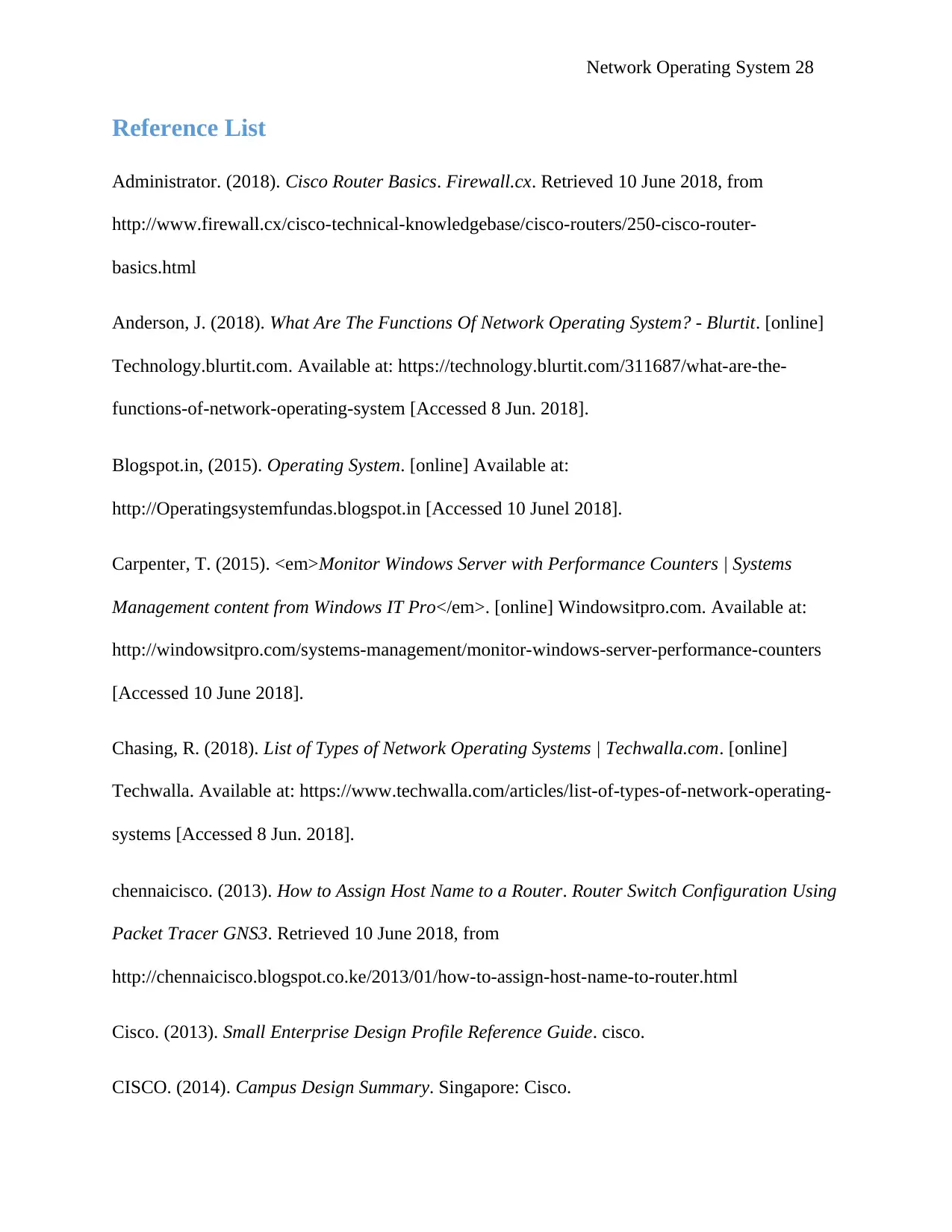
Network Operating System 28
Reference List
Administrator. (2018). Cisco Router Basics. Firewall.cx. Retrieved 10 June 2018, from
http://www.firewall.cx/cisco-technical-knowledgebase/cisco-routers/250-cisco-router-
basics.html
Anderson, J. (2018). What Are The Functions Of Network Operating System? - Blurtit. [online]
Technology.blurtit.com. Available at: https://technology.blurtit.com/311687/what-are-the-
functions-of-network-operating-system [Accessed 8 Jun. 2018].
Blogspot.in, (2015). Operating System. [online] Available at:
http://Operatingsystemfundas.blogspot.in [Accessed 10 Junel 2018].
Carpenter, T. (2015). <em>Monitor Windows Server with Performance Counters | Systems
Management content from Windows IT Pro</em>. [online] Windowsitpro.com. Available at:
http://windowsitpro.com/systems-management/monitor-windows-server-performance-counters
[Accessed 10 June 2018].
Chasing, R. (2018). List of Types of Network Operating Systems | Techwalla.com. [online]
Techwalla. Available at: https://www.techwalla.com/articles/list-of-types-of-network-operating-
systems [Accessed 8 Jun. 2018].
chennaicisco. (2013). How to Assign Host Name to a Router. Router Switch Configuration Using
Packet Tracer GNS3. Retrieved 10 June 2018, from
http://chennaicisco.blogspot.co.ke/2013/01/how-to-assign-host-name-to-router.html
Cisco. (2013). Small Enterprise Design Profile Reference Guide. cisco.
CISCO. (2014). Campus Design Summary. Singapore: Cisco.
Reference List
Administrator. (2018). Cisco Router Basics. Firewall.cx. Retrieved 10 June 2018, from
http://www.firewall.cx/cisco-technical-knowledgebase/cisco-routers/250-cisco-router-
basics.html
Anderson, J. (2018). What Are The Functions Of Network Operating System? - Blurtit. [online]
Technology.blurtit.com. Available at: https://technology.blurtit.com/311687/what-are-the-
functions-of-network-operating-system [Accessed 8 Jun. 2018].
Blogspot.in, (2015). Operating System. [online] Available at:
http://Operatingsystemfundas.blogspot.in [Accessed 10 Junel 2018].
Carpenter, T. (2015). <em>Monitor Windows Server with Performance Counters | Systems
Management content from Windows IT Pro</em>. [online] Windowsitpro.com. Available at:
http://windowsitpro.com/systems-management/monitor-windows-server-performance-counters
[Accessed 10 June 2018].
Chasing, R. (2018). List of Types of Network Operating Systems | Techwalla.com. [online]
Techwalla. Available at: https://www.techwalla.com/articles/list-of-types-of-network-operating-
systems [Accessed 8 Jun. 2018].
chennaicisco. (2013). How to Assign Host Name to a Router. Router Switch Configuration Using
Packet Tracer GNS3. Retrieved 10 June 2018, from
http://chennaicisco.blogspot.co.ke/2013/01/how-to-assign-host-name-to-router.html
Cisco. (2013). Small Enterprise Design Profile Reference Guide. cisco.
CISCO. (2014). Campus Design Summary. Singapore: Cisco.
Secure Best Marks with AI Grader
Need help grading? Try our AI Grader for instant feedback on your assignments.
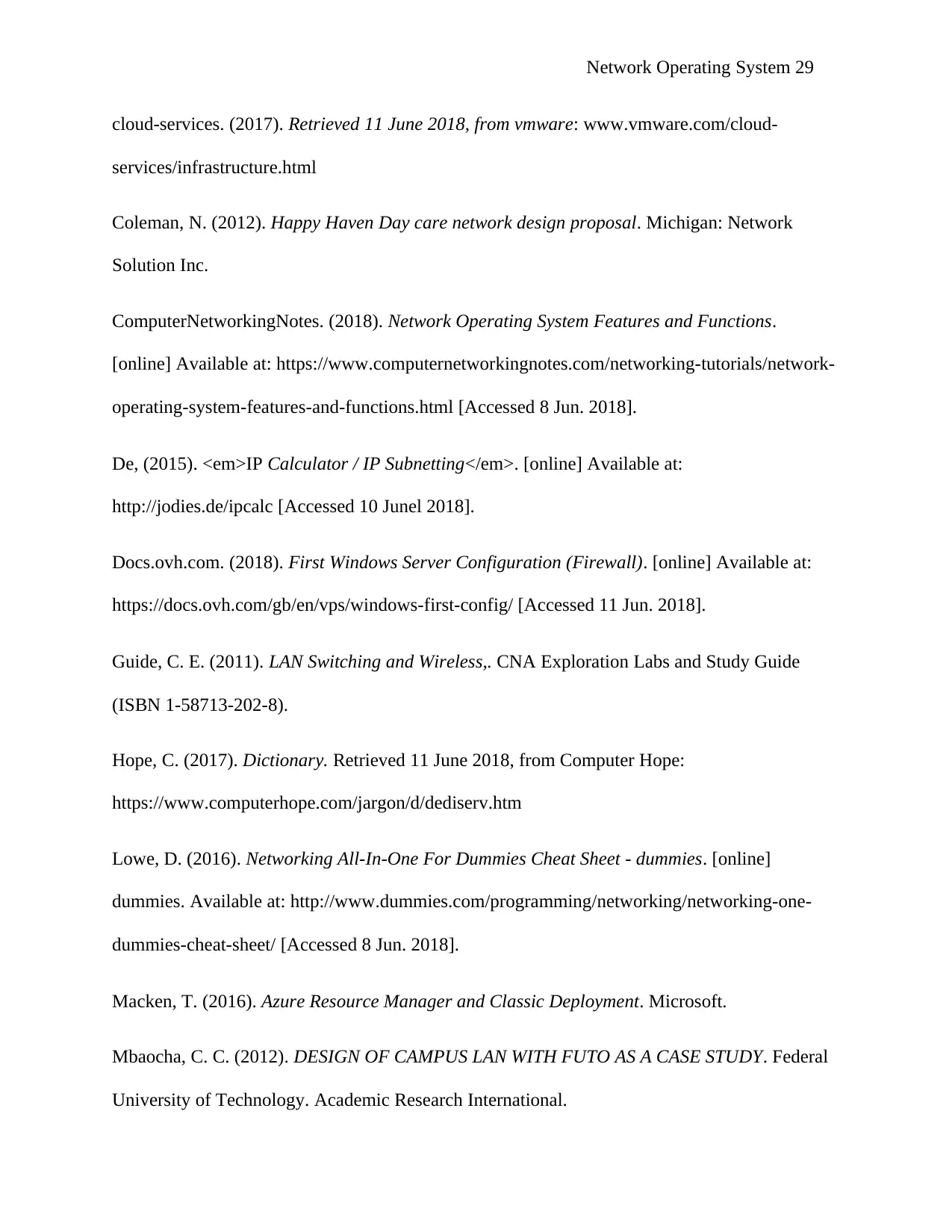
Network Operating System 29
cloud-services. (2017). Retrieved 11 June 2018, from vmware: www.vmware.com/cloud-
services/infrastructure.html
Coleman, N. (2012). Happy Haven Day care network design proposal. Michigan: Network
Solution Inc.
ComputerNetworkingNotes. (2018). Network Operating System Features and Functions.
[online] Available at: https://www.computernetworkingnotes.com/networking-tutorials/network-
operating-system-features-and-functions.html [Accessed 8 Jun. 2018].
De, (2015). <em>IP Calculator / IP Subnetting</em>. [online] Available at:
http://jodies.de/ipcalc [Accessed 10 Junel 2018].
Docs.ovh.com. (2018). First Windows Server Configuration (Firewall). [online] Available at:
https://docs.ovh.com/gb/en/vps/windows-first-config/ [Accessed 11 Jun. 2018].
Guide, C. E. (2011). LAN Switching and Wireless,. CNA Exploration Labs and Study Guide
(ISBN 1-58713-202-8).
Hope, C. (2017). Dictionary. Retrieved 11 June 2018, from Computer Hope:
https://www.computerhope.com/jargon/d/dediserv.htm
Lowe, D. (2016). Networking All-In-One For Dummies Cheat Sheet - dummies. [online]
dummies. Available at: http://www.dummies.com/programming/networking/networking-one-
dummies-cheat-sheet/ [Accessed 8 Jun. 2018].
Macken, T. (2016). Azure Resource Manager and Classic Deployment. Microsoft.
Mbaocha, C. C. (2012). DESIGN OF CAMPUS LAN WITH FUTO AS A CASE STUDY. Federal
University of Technology. Academic Research International.
cloud-services. (2017). Retrieved 11 June 2018, from vmware: www.vmware.com/cloud-
services/infrastructure.html
Coleman, N. (2012). Happy Haven Day care network design proposal. Michigan: Network
Solution Inc.
ComputerNetworkingNotes. (2018). Network Operating System Features and Functions.
[online] Available at: https://www.computernetworkingnotes.com/networking-tutorials/network-
operating-system-features-and-functions.html [Accessed 8 Jun. 2018].
De, (2015). <em>IP Calculator / IP Subnetting</em>. [online] Available at:
http://jodies.de/ipcalc [Accessed 10 Junel 2018].
Docs.ovh.com. (2018). First Windows Server Configuration (Firewall). [online] Available at:
https://docs.ovh.com/gb/en/vps/windows-first-config/ [Accessed 11 Jun. 2018].
Guide, C. E. (2011). LAN Switching and Wireless,. CNA Exploration Labs and Study Guide
(ISBN 1-58713-202-8).
Hope, C. (2017). Dictionary. Retrieved 11 June 2018, from Computer Hope:
https://www.computerhope.com/jargon/d/dediserv.htm
Lowe, D. (2016). Networking All-In-One For Dummies Cheat Sheet - dummies. [online]
dummies. Available at: http://www.dummies.com/programming/networking/networking-one-
dummies-cheat-sheet/ [Accessed 8 Jun. 2018].
Macken, T. (2016). Azure Resource Manager and Classic Deployment. Microsoft.
Mbaocha, C. C. (2012). DESIGN OF CAMPUS LAN WITH FUTO AS A CASE STUDY. Federal
University of Technology. Academic Research International.
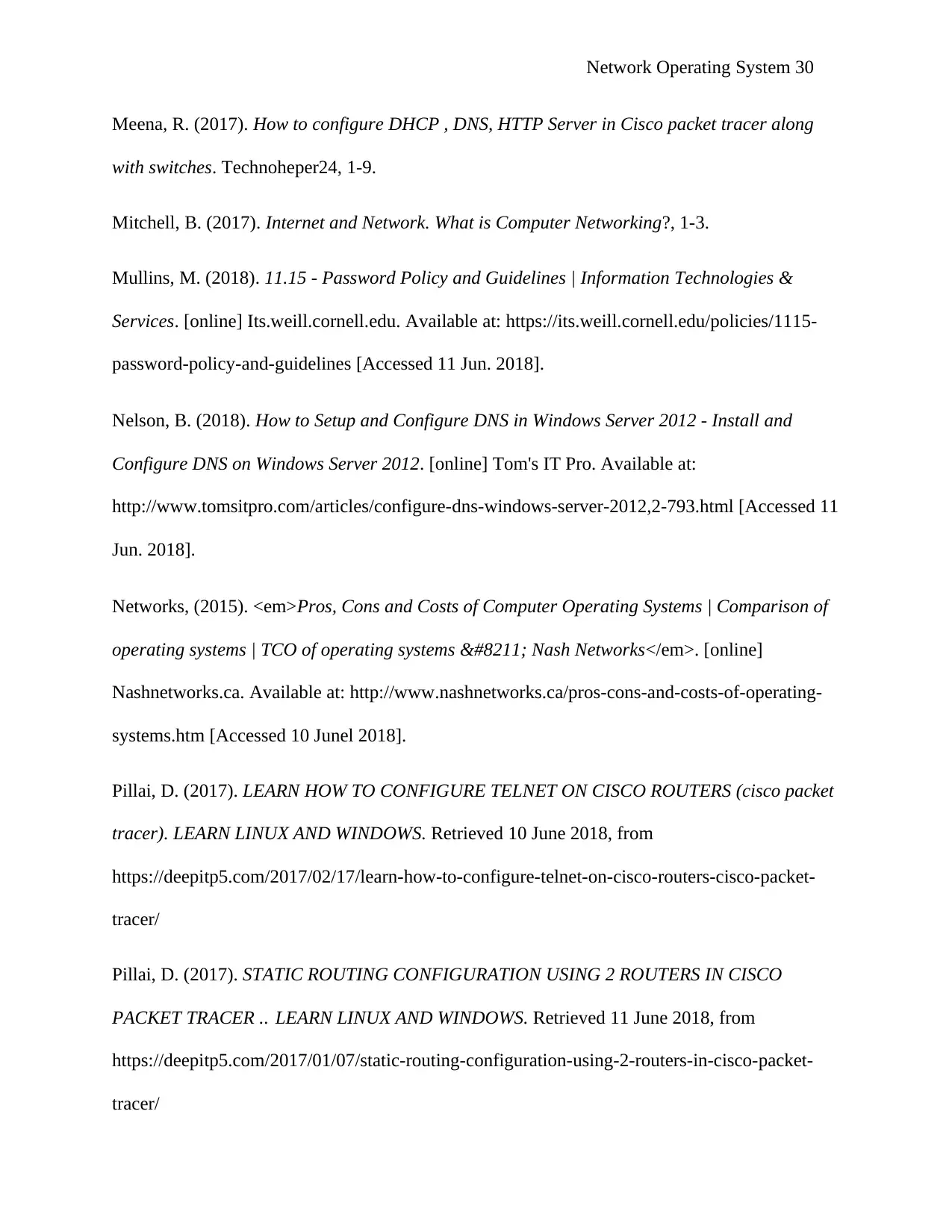
Network Operating System 30
Meena, R. (2017). How to configure DHCP , DNS, HTTP Server in Cisco packet tracer along
with switches. Technoheper24, 1-9.
Mitchell, B. (2017). Internet and Network. What is Computer Networking?, 1-3.
Mullins, M. (2018). 11.15 - Password Policy and Guidelines | Information Technologies &
Services. [online] Its.weill.cornell.edu. Available at: https://its.weill.cornell.edu/policies/1115-
password-policy-and-guidelines [Accessed 11 Jun. 2018].
Nelson, B. (2018). How to Setup and Configure DNS in Windows Server 2012 - Install and
Configure DNS on Windows Server 2012. [online] Tom's IT Pro. Available at:
http://www.tomsitpro.com/articles/configure-dns-windows-server-2012,2-793.html [Accessed 11
Jun. 2018].
Networks, (2015). <em>Pros, Cons and Costs of Computer Operating Systems | Comparison of
operating systems | TCO of operating systems – Nash Networks</em>. [online]
Nashnetworks.ca. Available at: http://www.nashnetworks.ca/pros-cons-and-costs-of-operating-
systems.htm [Accessed 10 Junel 2018].
Pillai, D. (2017). LEARN HOW TO CONFIGURE TELNET ON CISCO ROUTERS (cisco packet
tracer). LEARN LINUX AND WINDOWS. Retrieved 10 June 2018, from
https://deepitp5.com/2017/02/17/learn-how-to-configure-telnet-on-cisco-routers-cisco-packet-
tracer/
Pillai, D. (2017). STATIC ROUTING CONFIGURATION USING 2 ROUTERS IN CISCO
PACKET TRACER .. LEARN LINUX AND WINDOWS. Retrieved 11 June 2018, from
https://deepitp5.com/2017/01/07/static-routing-configuration-using-2-routers-in-cisco-packet-
tracer/
Meena, R. (2017). How to configure DHCP , DNS, HTTP Server in Cisco packet tracer along
with switches. Technoheper24, 1-9.
Mitchell, B. (2017). Internet and Network. What is Computer Networking?, 1-3.
Mullins, M. (2018). 11.15 - Password Policy and Guidelines | Information Technologies &
Services. [online] Its.weill.cornell.edu. Available at: https://its.weill.cornell.edu/policies/1115-
password-policy-and-guidelines [Accessed 11 Jun. 2018].
Nelson, B. (2018). How to Setup and Configure DNS in Windows Server 2012 - Install and
Configure DNS on Windows Server 2012. [online] Tom's IT Pro. Available at:
http://www.tomsitpro.com/articles/configure-dns-windows-server-2012,2-793.html [Accessed 11
Jun. 2018].
Networks, (2015). <em>Pros, Cons and Costs of Computer Operating Systems | Comparison of
operating systems | TCO of operating systems – Nash Networks</em>. [online]
Nashnetworks.ca. Available at: http://www.nashnetworks.ca/pros-cons-and-costs-of-operating-
systems.htm [Accessed 10 Junel 2018].
Pillai, D. (2017). LEARN HOW TO CONFIGURE TELNET ON CISCO ROUTERS (cisco packet
tracer). LEARN LINUX AND WINDOWS. Retrieved 10 June 2018, from
https://deepitp5.com/2017/02/17/learn-how-to-configure-telnet-on-cisco-routers-cisco-packet-
tracer/
Pillai, D. (2017). STATIC ROUTING CONFIGURATION USING 2 ROUTERS IN CISCO
PACKET TRACER .. LEARN LINUX AND WINDOWS. Retrieved 11 June 2018, from
https://deepitp5.com/2017/01/07/static-routing-configuration-using-2-routers-in-cisco-packet-
tracer/
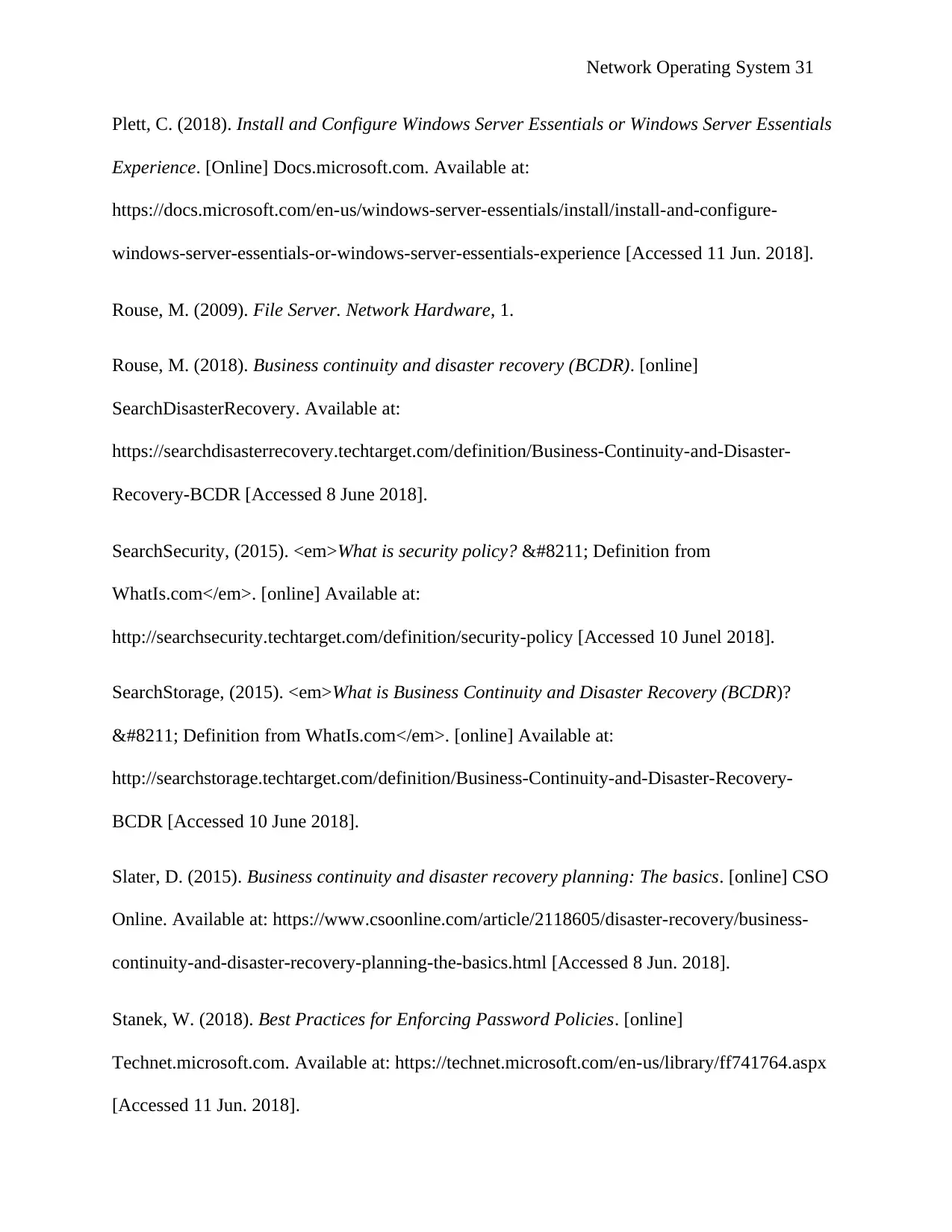
Network Operating System 31
Plett, C. (2018). Install and Configure Windows Server Essentials or Windows Server Essentials
Experience. [Online] Docs.microsoft.com. Available at:
https://docs.microsoft.com/en-us/windows-server-essentials/install/install-and-configure-
windows-server-essentials-or-windows-server-essentials-experience [Accessed 11 Jun. 2018].
Rouse, M. (2009). File Server. Network Hardware, 1.
Rouse, M. (2018). Business continuity and disaster recovery (BCDR). [online]
SearchDisasterRecovery. Available at:
https://searchdisasterrecovery.techtarget.com/definition/Business-Continuity-and-Disaster-
Recovery-BCDR [Accessed 8 June 2018].
SearchSecurity, (2015). <em>What is security policy? – Definition from
WhatIs.com</em>. [online] Available at:
http://searchsecurity.techtarget.com/definition/security-policy [Accessed 10 Junel 2018].
SearchStorage, (2015). <em>What is Business Continuity and Disaster Recovery (BCDR)?
– Definition from WhatIs.com</em>. [online] Available at:
http://searchstorage.techtarget.com/definition/Business-Continuity-and-Disaster-Recovery-
BCDR [Accessed 10 June 2018].
Slater, D. (2015). Business continuity and disaster recovery planning: The basics. [online] CSO
Online. Available at: https://www.csoonline.com/article/2118605/disaster-recovery/business-
continuity-and-disaster-recovery-planning-the-basics.html [Accessed 8 Jun. 2018].
Stanek, W. (2018). Best Practices for Enforcing Password Policies. [online]
Technet.microsoft.com. Available at: https://technet.microsoft.com/en-us/library/ff741764.aspx
[Accessed 11 Jun. 2018].
Plett, C. (2018). Install and Configure Windows Server Essentials or Windows Server Essentials
Experience. [Online] Docs.microsoft.com. Available at:
https://docs.microsoft.com/en-us/windows-server-essentials/install/install-and-configure-
windows-server-essentials-or-windows-server-essentials-experience [Accessed 11 Jun. 2018].
Rouse, M. (2009). File Server. Network Hardware, 1.
Rouse, M. (2018). Business continuity and disaster recovery (BCDR). [online]
SearchDisasterRecovery. Available at:
https://searchdisasterrecovery.techtarget.com/definition/Business-Continuity-and-Disaster-
Recovery-BCDR [Accessed 8 June 2018].
SearchSecurity, (2015). <em>What is security policy? – Definition from
WhatIs.com</em>. [online] Available at:
http://searchsecurity.techtarget.com/definition/security-policy [Accessed 10 Junel 2018].
SearchStorage, (2015). <em>What is Business Continuity and Disaster Recovery (BCDR)?
– Definition from WhatIs.com</em>. [online] Available at:
http://searchstorage.techtarget.com/definition/Business-Continuity-and-Disaster-Recovery-
BCDR [Accessed 10 June 2018].
Slater, D. (2015). Business continuity and disaster recovery planning: The basics. [online] CSO
Online. Available at: https://www.csoonline.com/article/2118605/disaster-recovery/business-
continuity-and-disaster-recovery-planning-the-basics.html [Accessed 8 Jun. 2018].
Stanek, W. (2018). Best Practices for Enforcing Password Policies. [online]
Technet.microsoft.com. Available at: https://technet.microsoft.com/en-us/library/ff741764.aspx
[Accessed 11 Jun. 2018].
Paraphrase This Document
Need a fresh take? Get an instant paraphrase of this document with our AI Paraphraser

Network Operating System 32
Subnetting. (2010). Retrieved September 10, 2017, from Ttutorial Point:
http://www.tutorialspoint.com/ipv4/ipv4_subnetting.htm
Technopedia. (2018). What is a Protocol Data Unit (PDU)? - Definition from Techopedia.
Techopedia.com. Retrieved 10 June 2018, from
https://www.techopedia.com/definition/25292/protocol-data-unit-pdu
www.tutorialspoint.com. (2018). Types of Operating System. [online] Available at:
https://www.tutorialspoint.com/operating_system/os_types.htm [Accessed 8 Jun. 2018].
Subnetting. (2010). Retrieved September 10, 2017, from Ttutorial Point:
http://www.tutorialspoint.com/ipv4/ipv4_subnetting.htm
Technopedia. (2018). What is a Protocol Data Unit (PDU)? - Definition from Techopedia.
Techopedia.com. Retrieved 10 June 2018, from
https://www.techopedia.com/definition/25292/protocol-data-unit-pdu
www.tutorialspoint.com. (2018). Types of Operating System. [online] Available at:
https://www.tutorialspoint.com/operating_system/os_types.htm [Accessed 8 Jun. 2018].
1 out of 32
Related Documents
Your All-in-One AI-Powered Toolkit for Academic Success.
+13062052269
info@desklib.com
Available 24*7 on WhatsApp / Email
![[object Object]](/_next/static/media/star-bottom.7253800d.svg)
Unlock your academic potential
© 2024 | Zucol Services PVT LTD | All rights reserved.




